Description of a trip to Saudi Arabia from January 31 to February 7, 2023
We wanted to go to Saudi Arabia long ago.
An artical was submitted to
an international conference. It was
accepted and published in Saudi Arabia, but no
invitations were issued to visit. This country was one of the most
closed. We didn't get upset. There are many interesting places on
the earth. Therefore, we
did not try to get there by any means and, at the end,
we abandoned the idea of traveling to this
country for an indefinite time.
This trip came about as follows. On December 24th I received an email from our Polish friend Wojciech Dabrovski, who wrote that he was going to Saudi Arabia. I immediately checked the Internet and realized that Saudi Arabia has greatly simplified the issuance of tourist visas. I wrote to Wojtek and received confirmation from him that this is indeed the case. On January 7, we all received electronic multiple entry visas to Saudi Arabia for a period of one year. Almost immediately we got air tickets to this country. It took about half an hour to get three visas.
We decided to come to this country for a week because there were many uncertainty. We began to choose interesting places and I realized that the available time would not be enough. Thus, we began to choose the most important places. We decided to rent a car and to drive from Riyadh, first to the east towards the Persian Gulf. Then return to Riyadh and drive west towards Hegra (Hegra) and Medina (Medina). I really wanted to visit the Edge of the World. About the last place on the official website of Saudi Arabia (https://www.visitsaudi.com/en/see-do/destinations/riyadh/edge-of-the-world) it was written: Edge of the World (currently closed). We were lucky and we visited everything we planned. Information about our trip is written below.
We decided to rent a car twice. The first time
from the evening of January 31 to the evening of February 2. The second
time from the evening of February 2 to the evening of February 6.
Finally it was done. The reason is simple.
According to descriptions available
at the Internet, bad roads lead to the "Edge
of the World". Therefore, we decided to take one cheaper car and go
east. The second car was ordered (we expected)
with higher clearance and
with more power. We did hope it might be
properly used to drive to the west,
including the "Edge of the World". Finally it
was done. We drove 3622 km in two cars. The cars were registered only for
me. We learned that Iouliia (my daughter)
could also register a car for herself. This is because
currently, women in Saudi Arabia can drive cars.
We had many questions about the need for an
international driver's license. The information was conflicting. Some
rental companies explicitly stated that an international driver's
license was required. In our company Sixt such
requirement was not written. I, just in case, nevertheless issued
an international driver's licence, but
when we rented cars, we did not show international
driving licence. No questions arose. That is, in Sixt Riyadh, an
international driver's license is not required. In Portugal, I issued
the licence in 10 minutes and for 30 Euros. I
applied directly to the traffic police (itís cheaper) and didnít apply
to the auto-motor club (itís almost twice
more expensive there).
January 31,
2023 (on the night of
January 30-31). We left the house
at 03h15m. We flew by Luftansa aircraft from
the Portuguese city of Porto. First (at 06h15m in the morning we flew to
Frankfurt; about 2.5 hours). Then (at 12h15m we flew
from Frankfurt to Riyadh; for 5
hours). Upon arrival, we immediately took the
rented car from Sixt. We rented the smallest car, but with all
the available insurances and with an increase in the allowable mileage up to 1500 km.
We paid for two days about 135 Euros. About
half of the rental cost was spent on insurance and additional mileage.
On this day we reached the hotel in Riyadh (30 km or so) and spent the night.
February 1, 2023. Early in the morning we left the hotel and drove approximately to the southeast. Our route for this day is shown on the map below. The first stop was at the place Judah Thumb. About the last seven kilometers there is a country road. It is well-knurled and does not slip. It's easy to drive. The soil appears to be good. Even if you move directly to the rock (on a hill), the wheels do not slip.
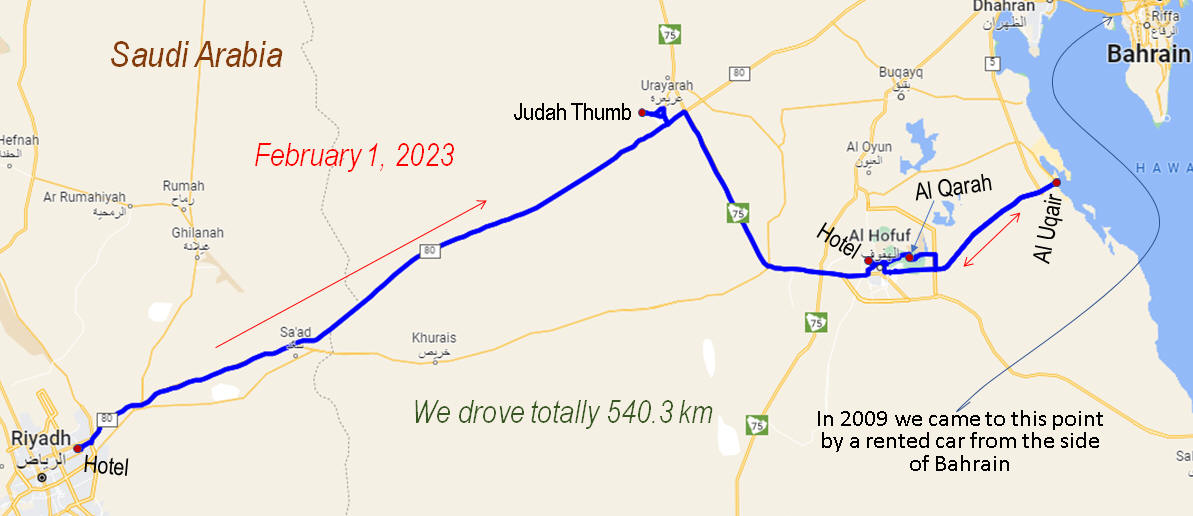
The left picture below shows our first rental car. On the right picture you can see the Judah Thumb.
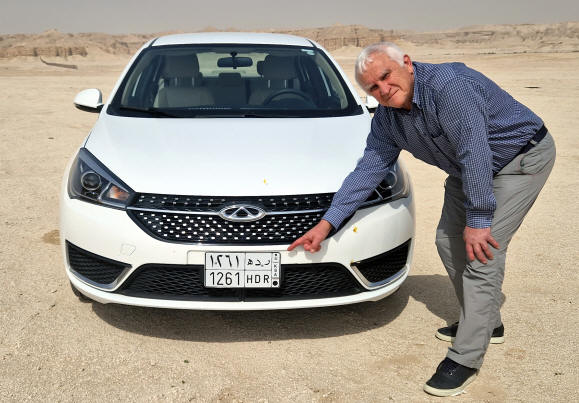
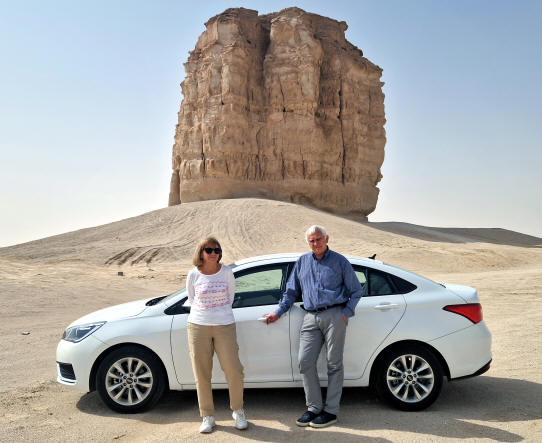
The picture on the left (below) shows the same place again (Judah Thumb). On the right picture: we drove here by the car. It was also possible (for the car) to drive up to the hill with the rock (Judah Thumb). I.e. we could drive to the place where Iouliia is on the picture on the left-hand side below.


The next stop was near the mountain Al Qarah. In around you can see almost flat terrain and the mountain rises, as it were. We parked the car near the entrance. This place is quite cultural and you need to take tickets. Visiting this place was just completed by a group from a cruise ship. Inside the mountain you can see passages (caves) with illumination surrounded by bizarre rock formations. The cruise group had already left and people (when we were there) were practically not met.
There are four photographs below taken inside the mountain (in the cave passages).



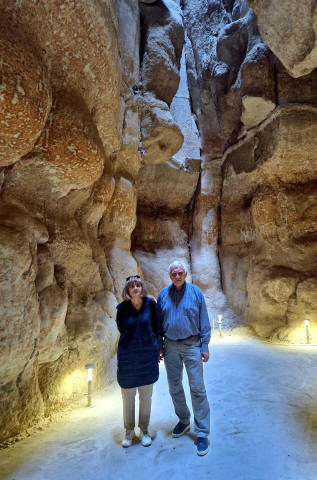
The following photos are taken outside the cave (but in the place where
we went on tickets).


From the mountain we drove to the settlement of Al Uqair or Al Uqayr. On the Internet, it is easy to find a tourist guide to this place on the Persian Gulf. Unfortunately, what is written on the Internet today is impossible to see. We drove up to the town. The entrance is blocked, but you can go through. We drove around and ended up, apparently, in some kind of military unit. We returned back. We talked with local people. We were told that everything of the past has ceased to exist today. People did not recommend us to go on the territory of the village, because it is dangerous. We took a few photos (see below), turned around and drove to spend the night at a hotel in the city of Al-Hofuf.
The left photo below shows
an interesting traffic sign near the road. We actually saw a lot of
camels. The right picture was taken near the entrance to the village of
Al-Uqair (you can see Persian Gulf on the
right hand side).
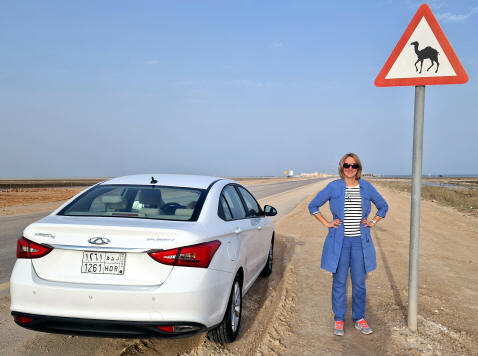

A few words about highways. Many of them are fast with speed limits of
120 and 140 kilometers per hour. There are many good roads, but there
are also many roads that are partially broken.
Bad sections are found even where the speed limit is 120 kilometers per
hour. There are places where sand swirls over the road.
We saw warnings about sandstorms. Landscapes
are not pleasing to the eye. Mostly we could see
flat desert areas. The second part of the road trip (from Riyadh
to the west) passed through beautiful mountain formations.
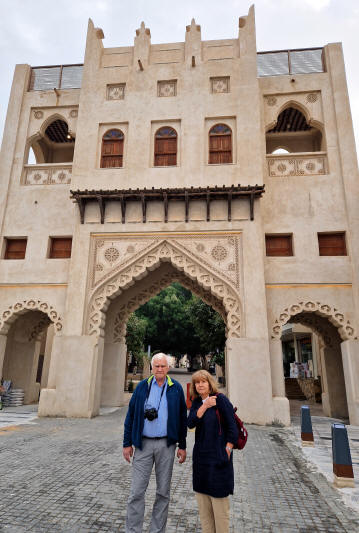
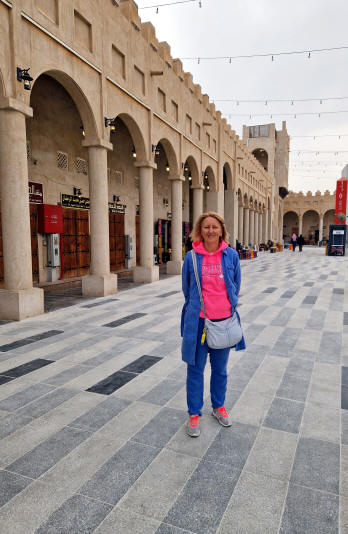

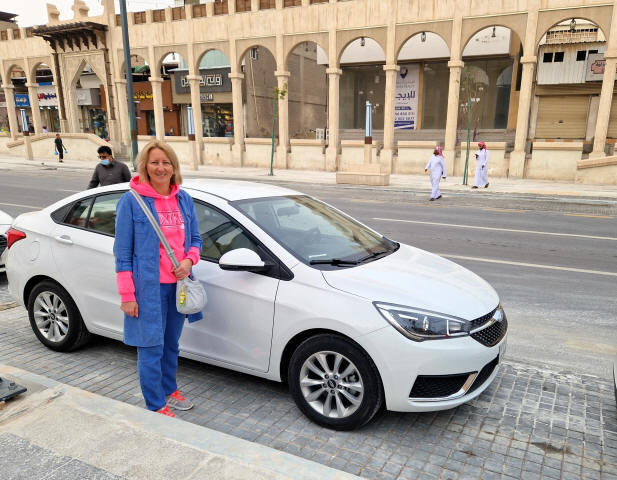
Then we drove back towards the capital of Saudi Arabia, Riyadh. The path of this day is shown on the map below. The first stop was near the Heet cave. You can find many interesting things on the Internet, including the fact that the water of the cave lake is the cleanest in the world. A dirt road leads to the cave. There are no pointers. When we arrived, there was one car (with local residents), which soon left. The people in the car greeted us warmly and said to be careful because rocks were falling from above.
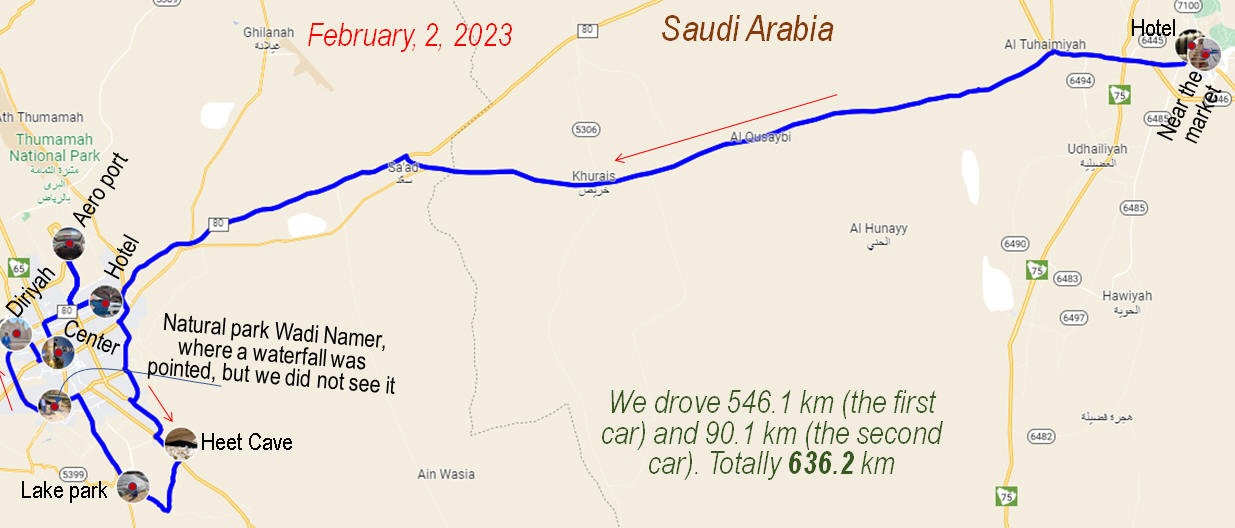
We got out of the car and went to the cave. The way down passes over
large stones. There are steep cliffs nearby, from where stones can
certainly fall. I went down alone. There is a lake in which some kind of
barrel and a lot of different garbage floated. We didn't like this
place.
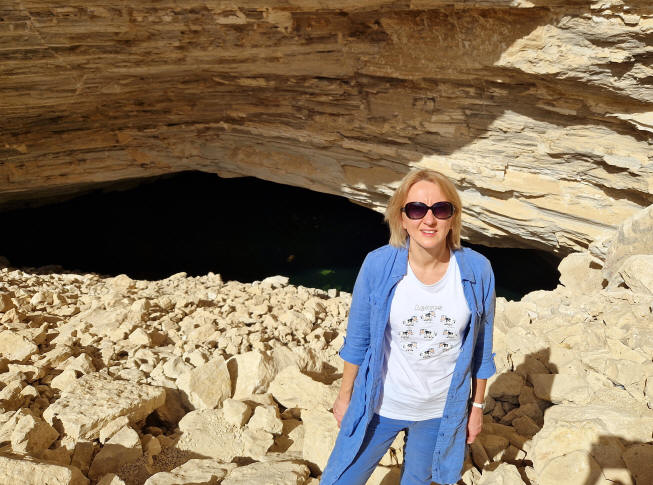
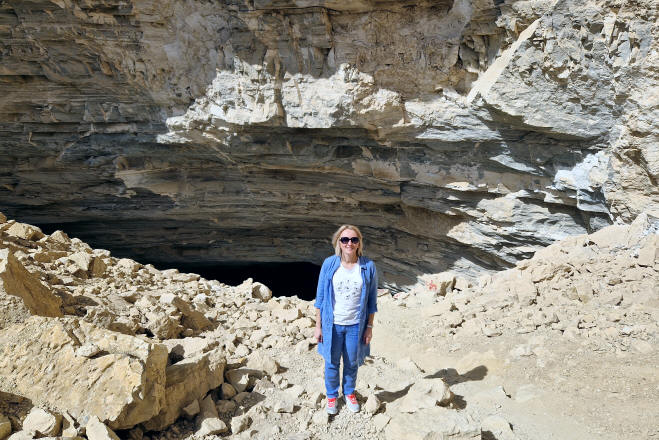
The pictures below are also taken near the cave. The middle picture shows where we parked the car. On the right picture, I'm going to leave.
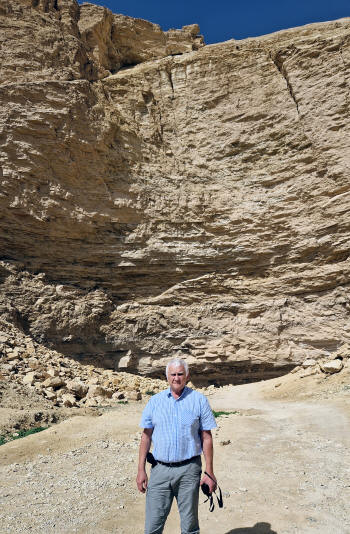

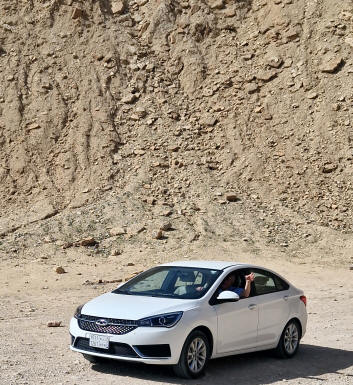
The next stop was at the Lake park or Al Hair - Al Haeer Lake park. We drove through the park. We looked at the lake with a long low waterfall, which is shown in the left picture below. We drove up to the waterfall Wadi Namer (Wadi Namer), which was supposed to be located in a natural park. This place (natural park) was found, but there was no waterfall (see right photo below).
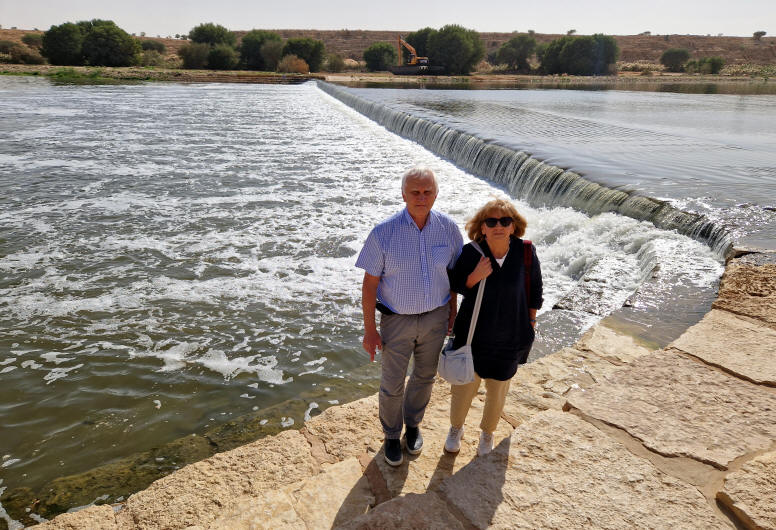
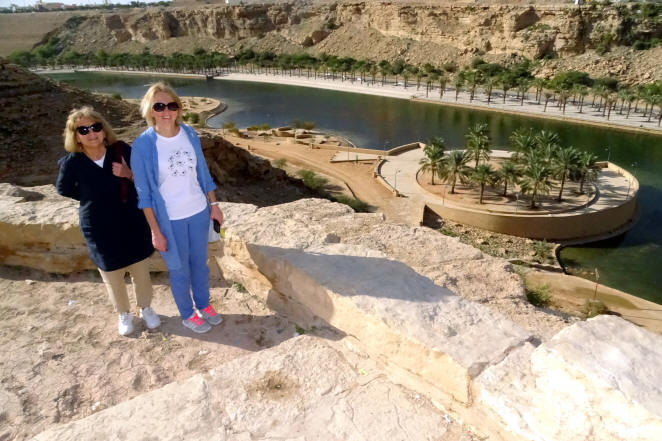
Then we went to the city of Diriyah, which was the first capital of the Saudis (apparently in 1727-1818). It is located on the northwestern outskirts of Riyadh. There was a lot of traffic at the entrance. We turned into one of the proposed parking places. We saw the entrance to the parking lot. We were stopped by an employee and asked if we had some kind of card. We answered "no". Then the employee suggested that we take the right path. We drove in and out of the parking lot. We started looking for a new place and were able to park on the street, from where it was not far from Diriyah. We measured the general way to this city (from the parking lot to Diriyah) and back. The total distance (passing on foot) was 3.2 km. So we parked well. The parking place is shown in the left photo below and its coordinates (GPS) are as follows:
 The
right picture was taken already in this city (Diriyah). First, I'll
write how we got there (on foot).
The
right picture was taken already in this city (Diriyah). First, I'll
write how we got there (on foot).


We approached the entrance. There is a pass system. We were asked if we have an order for this place or a restaurant order in the territory of this place. We answered that we had nothing. Then the employee said "You are our guests and therefore I will let you through." So we got there. In the territory of Diriyah there were many people in Arab clothes. We visited this place at the end of the day on a Thursday. Perhaps this number of visitors is due to the pre-holiday time. We crossed the bridge (as we understood through the water in the Hanifa valley). Further, the path leads through the old city of Diriyah, basically along one route (first to the right; then along the circular path to the exit from this city). We passed through the buildings, which are restored and cultivated (one might say licked). There are a lot of people. Partially destroyed buildings were seen along the edges. The history felt bad. The buildings are neat and, apparently, recently well prepared. It is clear that Diriyah is an important place in the history of Saudi Arabia, but I cannot say that we liked this place very much. In a few days we will pass through other villages that have more of an Arab world history. We liked it there more (see the trip on February 6).
Below are photos from the old city of
Diriyah. The photo on the left was taken at the start of the journey.
All these buildings appear to have been well restored. In the right
picture (taken approximately in the middle of the way), apparently,
really old buildings.
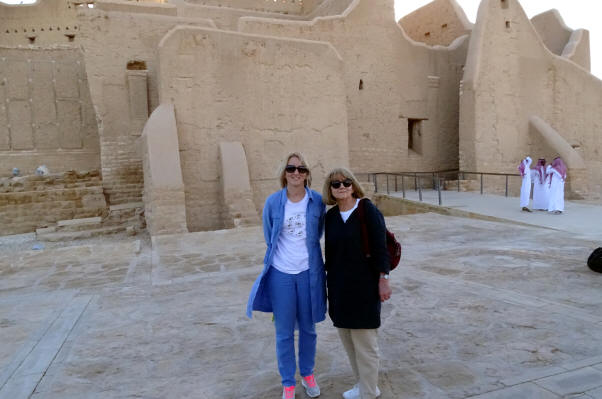

The left picture below was taken at the beginning of the second half of the journey. It has ruined old buildings. The two right shots were taken at the end of the road through the city. We constantly made new acquaintances, and in most cases people themselves offered us to be photographed. We liked the people of Saudi Arabia that we met.
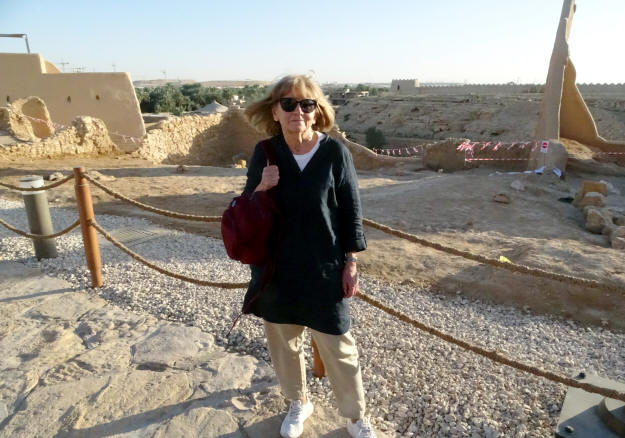
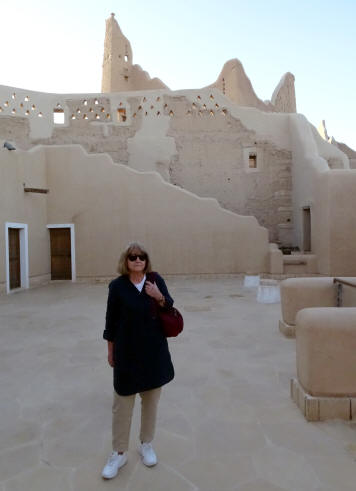

Then we left the Diriyah area and drove for a long time through the center of the city of Riyadh. Below you can see the last photos of this day. There are many cars in the city. There are frequent traffic jams. We spent more time in the center than we would expect. We drove around the city for about 50 km and spent about 3 hours on this last part of the trip.It was from about 18 to 21 hours, mostly in the dark.
The
left picture below shows the tower of Al
Faisaliyah with 267 meters high. It is a
commercial skyscraper and it is the first
skyscraper built in Saudi Arabia. The picture near
was taken from a car window. It shows the tower of Al-Mamlaka in the
Center of the Kingdom (at 302 meters high).
It is the third tallest building with a hole
in the world.
We drove back to the hotel (30 km). The car is
also automatic. I liked the fact that the car
responded well to any wish of the driver (again, the
car was registered only for me).
Apparently, there was a good supply of power. On the way to the hotel,
Iouliia's phone rang. We didn't answer. When
we arrived to the hotel, we listened to an
audio message from our rental company with "good news". We left our
camera and my glasses in the previous car.We
had to go to the airport again. So we drove 90 km in a new car in the
evening and went to bed at midnight. Again, I want to say good things
about people (now from Sixt rental company).

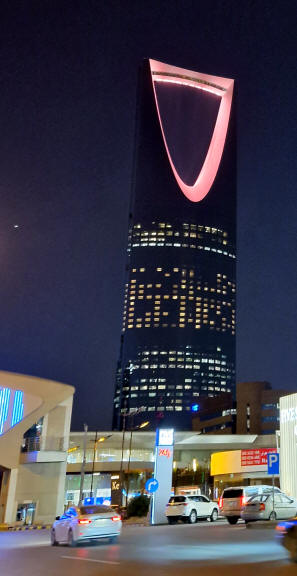
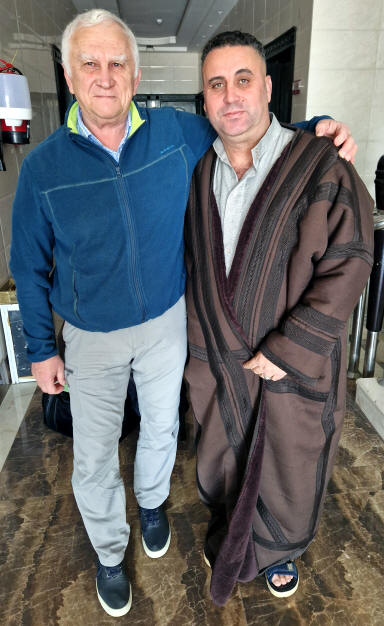

The next day, a trip to the Edge of the World was planned, about which it will be written below in great detail. Nevertheless, we decided to sleep a bit more, since we were already pretty tired.
February 3, 2023. We left in the morning at 8h40m. Before leaving, we took pictures with the hotel workers (see the right two pictures above), who were already ready (dressed appropriately). We were pleased and again had good impressions about people from Saudi Arabia
Finally we
visited the Edge of the World and I
will write in great detail below about this trip. The reasons are. There
were actually many people in this place. I
read everything I could find at the Internet.
I studied all possible roads, but still, there was no clarity. The
reasons are.
We have been trying
to communicate electronically with some people whose descriptions we
read on the Internet. No replies received. This is fine. Most often this
is what happens.
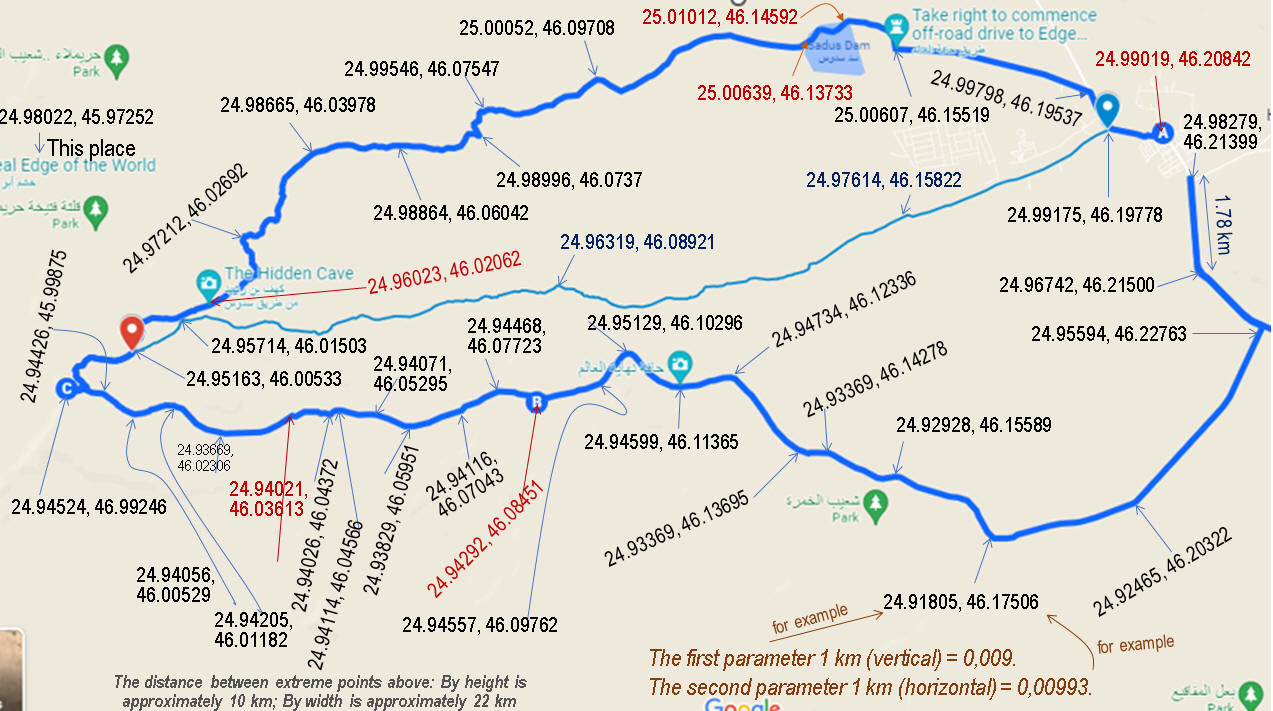
The lower road on the map (according to information on the Internet) is open only on Friday and Saturday. This road should go through the Acacia valley. We partially drove the beginning of this path (see the description below) and there, as we understood, it is impossible to drive to the Edge of the World. We did not take the middle road, which is recommended even for small cars. In one of the descriptions on the Internet, it was written that at the end of the road this road was dug up by a bulldozer and it was impossible to drive there. Looking ahead, I note that bulldozer hill is possibly located in the same place on the middle and upper paths on the map above (this will be written later).
Now I will tell more about how we drove. Below is a map of our path to the beginning of the trek (continuing on foot). We arrived at the turn to Acacia valley. Road 5762 is one-way. There is a dividing line between the sides. Therefore, Google leads first to the settlement of Sadus, and then back along the same road. In the area of the turn, it is easy to cross over the dividing strip. So we immediately turned left. Then there is a good asphalt road. We tried to follow to the trajectory (see the map above). After about 7-8 km from the road 5762, the new road began to deviate from the trajectory. We drove up to some construction buildings. We asked and they turned us back. About a kilometer from the end point of our route (on the way back) we saw a working car that was moving off the road towards the correct trajectory. We went to the same exit (see the map below). On the right-hand side, in the distance, we saw a closed gate, which was unlike those that we saw on the Internet. The working vehicle in front of us went to the left and again began to move away from the correct trajectory. We returned to the main road and after about a kilometer on the right (driving towards road 5762) we saw a man in a nearby house. This location is shown on the map below. We stopped for talking. The man spoke good English. He introduced himself as a man who knew this place and all the surrounding roads well.We asked about the Edge of the World. He said that the road to Acacia valley is now impossible to drive. The road is closed and a construction work is underway. He said that officially the government of Saudi Arabia forbids travel to the Edge of the World (this is also written on the official website of this country), but often closes the eyes. He said that it would be possible to drive to the Edge of the World, but this was completely out of the question (certantly impossible) for our car. He said that the road went through the Sadus dam and that it was blocked closer to the "Edge of the World" by a moat that a bulldozer had made. He could not say exactly where this ditch was. We got upset and drove back to the main road (5762).

I suggested trying to drive across the Sadus Dam.
Iouliia supported. The idea was the following.
Drive as far as we can and continue on foot if time permits. We
continued on our way under Tania's
disagreement. We reached Sadus and drove along the trajectory (see the
map I prepared with the coordinates above) to the dam. After the turn
(from the main road 5762) at first there was an asphalt road, but after
a while we left it. The subsequent route is shown
and marked on the map below. From Riyadh to the Sadus dam, we
drove for about an hour and a half. The total distance, taking into
account the exit from the main road (towards the Acacia Valley), was
about 90 km. That is, we were driving (taking into account stops and
conversations) quite quickly.
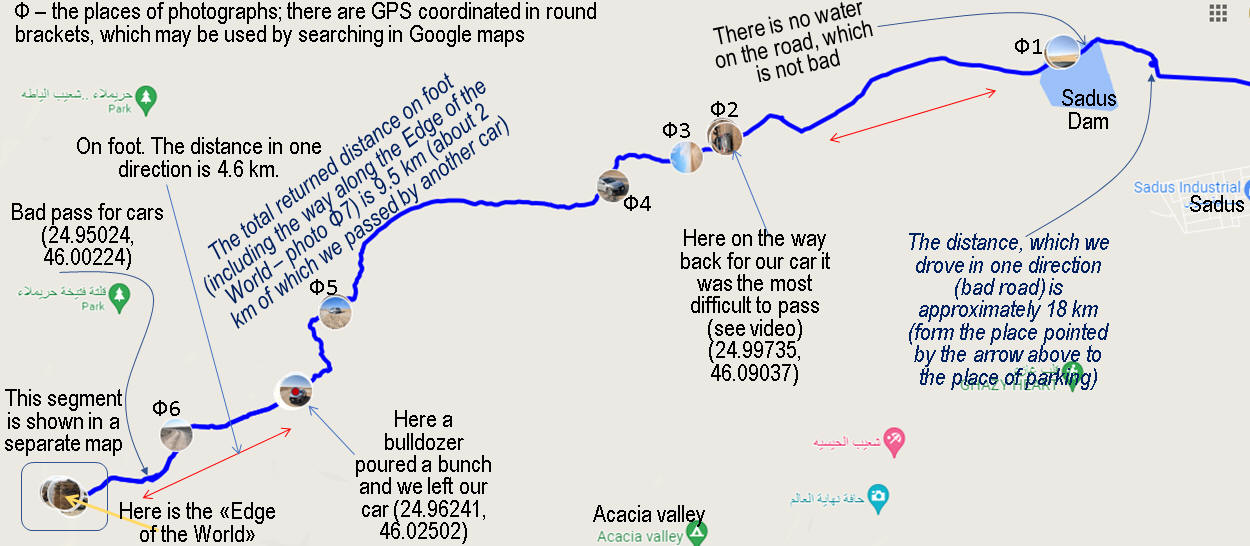
Immediately after the exit onto a bad road (see the place shown on the map above in front of the Sadus dam) we saw a car with local people. We talked to them. They said that now this is the only road that leads to the "Edge of the World." They said to us that it was absolutely impossible to drive in our car and we needed a high four-wheel drive jeep. They also said that at the end the road was dug up (a shaft was made). We decided to go anyway. There is no water near the dam and the road is not bad even for our car. Dry rivers were crossed several times. Such places were the worst, as there was almost always a descent and ascent. The worst such place was, perhaps, in the place of the photo Ф2 (again for our car). About halfway we met a man in a jeep. He waved his hands at us, said that it was impossible to drive in our car. He himself drove to the place of the shaft and turned back, without visiting the Edge of the World. We asked how far from the Edge of the World is dug up place (shaft). He answered that 5-7 km. We decided go further. Iouliia and I constantly had the same thought. If we do not reach 5-6 km, then it is clear that we will go further on foot. And if it is 8-10 km, then we can go on foot, but we wonít have time to return before dark. How then to return along such a road in the dark?
There were very few other cars on the way there. We reached the shaft, which dug up a bulldozer to block the road. We parked the car. Several fairly large four-wheel drive vehicles were parked nearby. We saw that large jeeps overpassed through the dug-up shaft. We left the car and went on foot. The road is good, the weather is cool. Walking was easy (see map below). We walked about 3 km and next to us stopped a jeep driven by an Arab man. He was alone. The car was littered with various things. However, he dumped it all in a corner, sat us down, and we drove together to the Edge of the World. At the end, rather deep ditches crossed (see this place in the map above). In 10 minutes we were already there. Below is a map of the route from where we parked our car. We made photos with an Arab driver. He even treated us to some Arabic cookies. All this is free. The driver left a very pleasant impression. On the way, he said that the road was blocked due to problems. He said that one car with three tourists fell down. I don't know how true it is.
Note that a map that can be opened with "Google maps", with photo locations marked, is here: https://www.google.com/maps/d/u/0/edit?hl=en&mid=15gzBrHWYeVZuqFg5-ypq9zNGtnW05dc&ll=24.966540659487627%2C46.07628190499804&z=12

We said goodbye and continued on foot. All places are close by. I think
we walked 700-800 meters to and back. First,
we walk along the edge of a deep cliff. Then
we left Tania and went with
Iouliia further to two towering pillar-like rocks. There were no
people. We took pictures on the rocks alone. The lighting was good. On
the Internet, almost all the photos on these pillar-like rocks were
taken with a large number of people. Below are photos, and then our way
back is described and general comments on the trip to this place are
given.
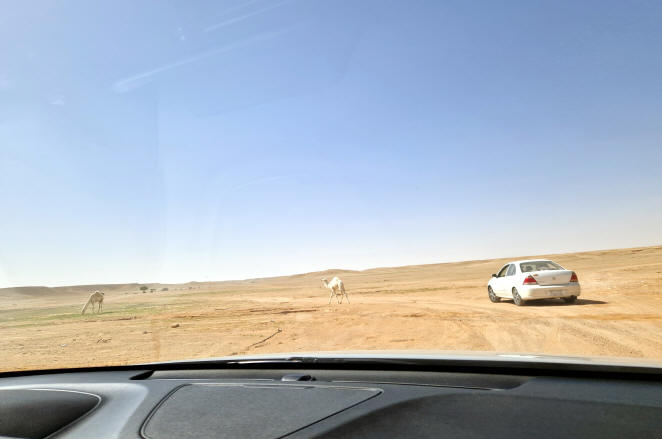
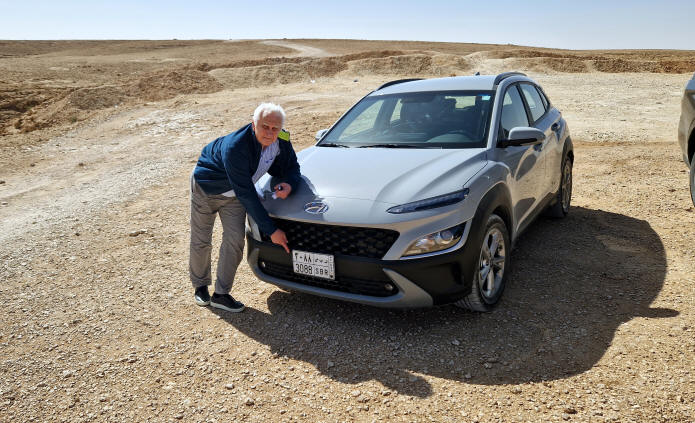
The left picture below (marked as Ф15 on the map) shows the person who gave us a lift. Such car can be driven without problems. The right picture, taken in the same place, once again shows a car for which the road here is a trifle. We have traveled a lot in the past in similar cars and the corresponding comments about the road to the Edge of the World will be given below.
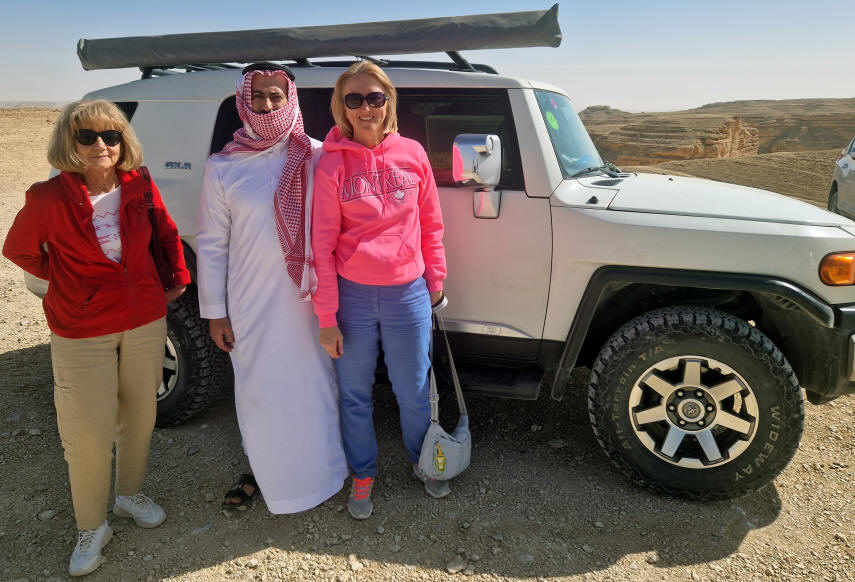

In the next two shots (labeled Ф11) we are in the area of the Edge of the World. This place is truly unique. For all this trip (to Saudi Arabia) we liked it the most.
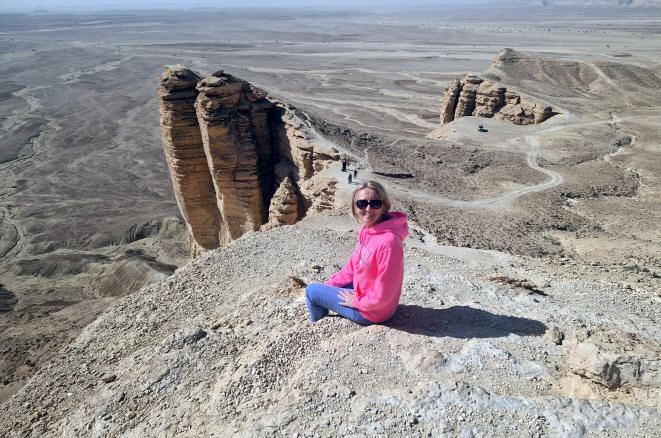
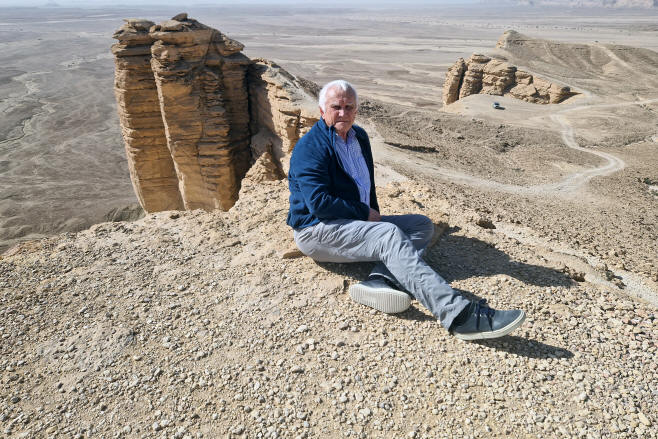
The bottom two shots were taken at the top of the far cliff (this place is marked on the map as Ф7). This columnar rock is the farthest in the top two shots. There was no one else there except Iouliia and me.


In the left picture below, Iouliia is on the top of a cliff. The right photo shows the edge of the cliff. There were almost no other people there. The left image below shows a long crack in the nearby rock. When we went to the far rock, we saw this crack up close. It is quite large and, in my opinion, it can lead to the destruction of the rock.
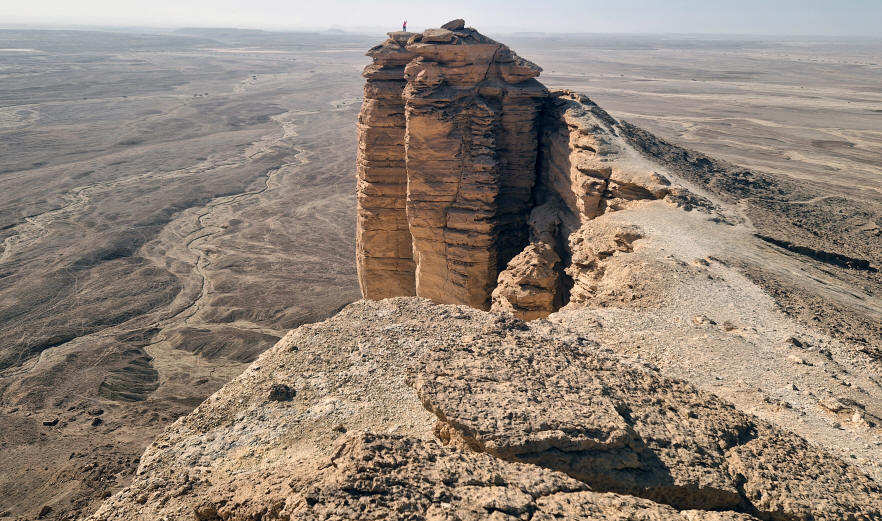
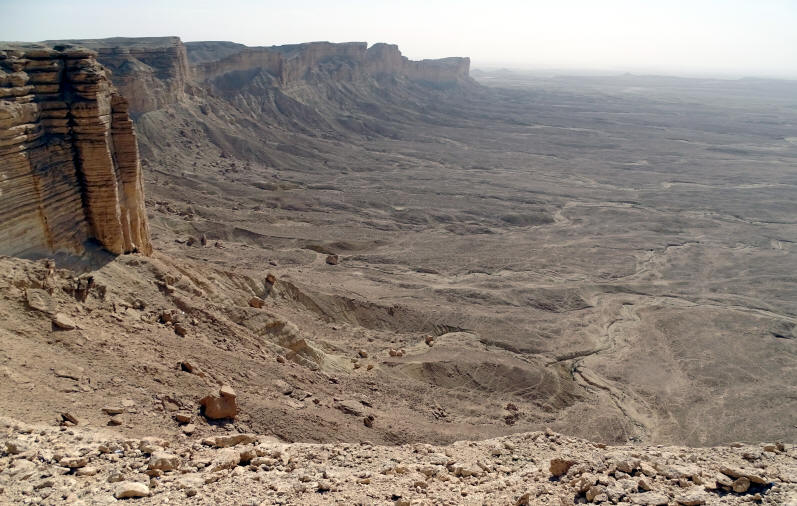
We did not see serious dangers on the way there, but, as you know, you can find problems everywhere. Below are photos showing the last part of the way. The bottom pictures (this place is marked as Ф11 on the map) show the first part of the way from the parking lot where we were brought. It can be seen that there are several other cars above (in the parking lot). First, you pass along the edge of a high cliff. There is probably a danger of collapse, but I think it is very small. People have been going here for a long time and constantly. It is better not to look down and not to approach the edge with a cliff. If these elementary requirements are met, then the danger is minimal.
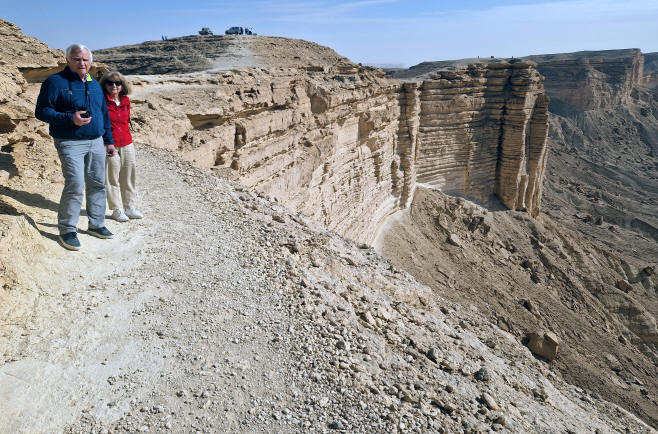

The left picture below shows where we left Tania while walking on pillar-shaped rocks (this place is marked as Ф11 on the map). In principle, everything is perfectly visible from there. Tania said that she had admired enough, and at the same time had a rest. The further way from here to the top of the pillar-shaped rocks, in my opinion, is quite simple. Caution, of course, is necessary, but in this case it is minimal. The leg can be twisted, but there is almost no chance of falling down. The right picture below was taken not far from where we left Tania. It can be seen that other people appeared on the top of the cliff (only a couple of people).
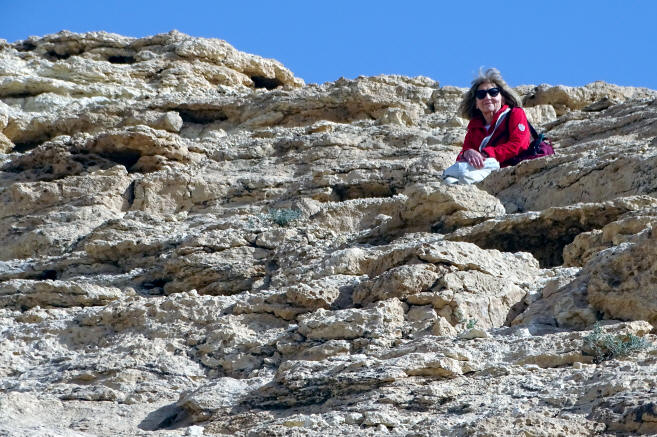
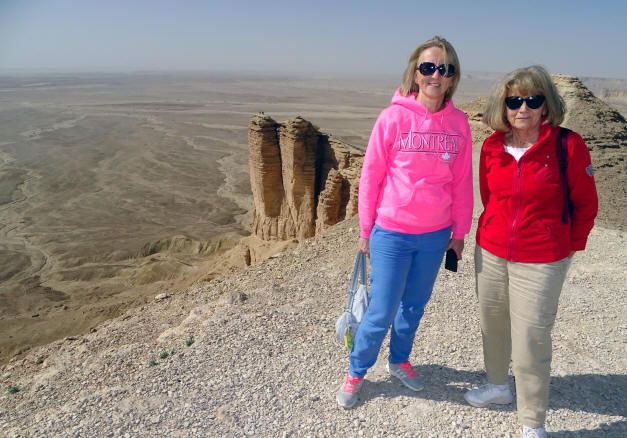
There are below four more shots showing this magnificent place.
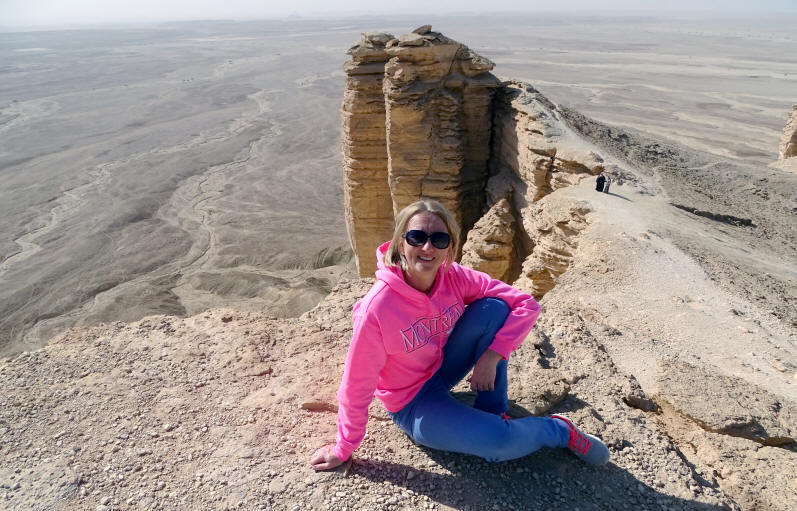

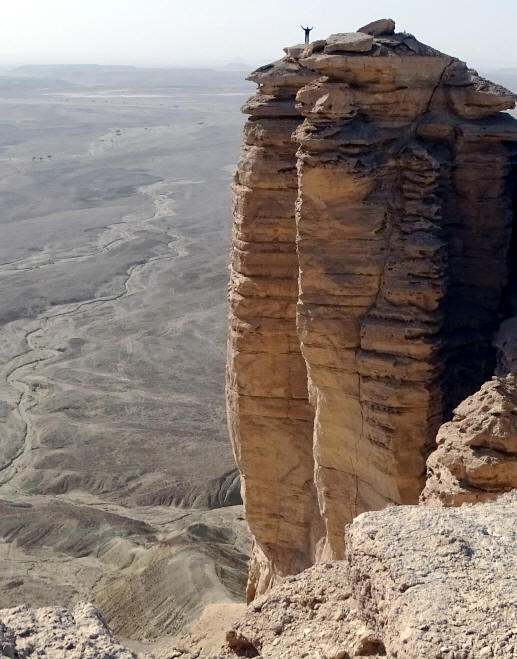
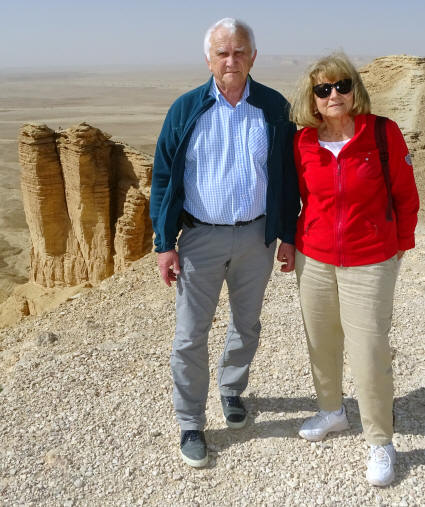
We went back and tried to take more photos of the path and show other details. When we passed the parking lot (somewhere between Ф14 and Ф15), we were hailed from above and offered a taxi, but we refused. So we went back on foot. We looked at where bad places need to be passed. On a small car (like ours) it is definitely impossible to drive there. From the bad place to drive through (shown on the map above) to the parking lot at the Edge of the World is about 1.25 km. Many people leave their (even quite large) cars there. The distance back to our car was 4.6 km from the parking lot. Walking is easy. Not hot. The road is good (see the left picture below, the place of which is marked Ф6 on the map above). It is a pity that the shaft was made so far away. If it had been made about 1.3 km before the place (the last parking lot at the Edge of the World), then we would have driven here in our small car. We passed (on foot) a Hidden Cave, climbing into which there was no desire. We have already seen many similar places. Finally we came to our car. Nearby, in front of the rampart from the side of the Edge of the World, there was already a taxi (see the right picture below). We asked how much it cost. We were told 100 riyals one way, that is, approximately 25 Euros (as we understood for all passengers). You probably need to ride in the back of the car. For those for whom 4.5 km of walking is a lot, it is possible take a ride.
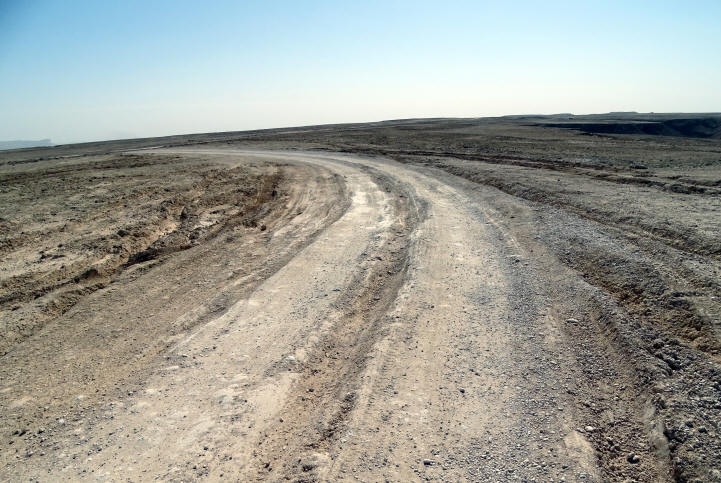
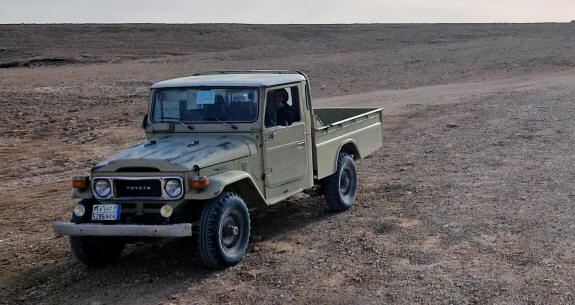
The left picture below shows the shaft through which large (4-wheel drive) cars pass. The right picture shows our car, which arrived here. Now we have to go back. This is the very thought that completely occupied Tania's head.
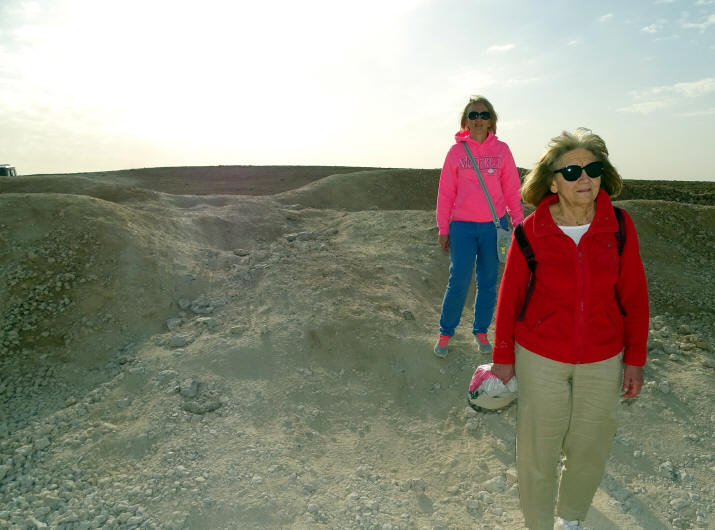
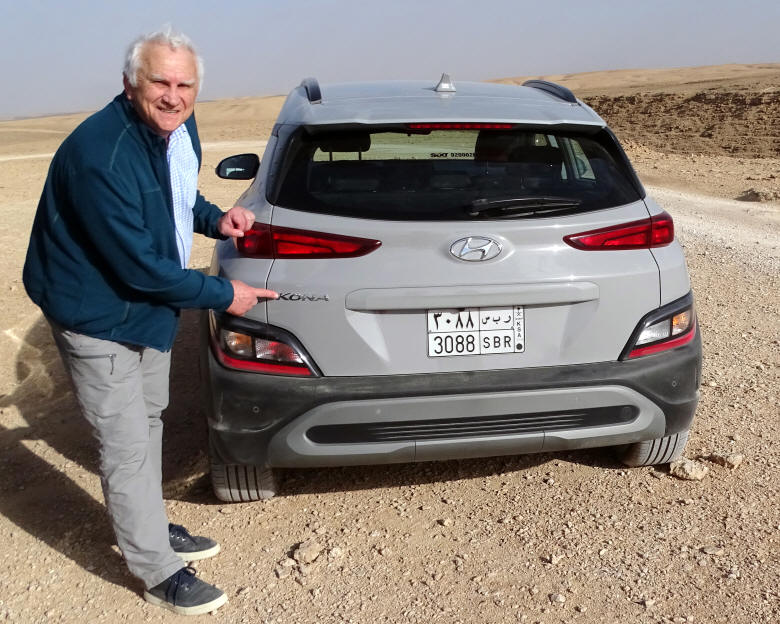
We drove slowly and for a long time. But we succesfully returned back and the car was not damaged anywhere. We didn't even get too dirty. Iouliia often went out and watched so that I didnít run into something. The road back seemed more difficult. In those places where we went down on the way here, on the way back we had to climb and the wheels sometimes slipped. All such places are clearly visible on the video (the files of which have a link: https://uapt33090-my.sharepoint.com/:f:/g/personal/skl_ua_pt/EqGbYDpDCcFCpDpVabmIQL4BCWyl2x4_NxRNA5SAJ11DGA?e=h7BGRV ). Below are the pictures.
The shooting location of the left photo below is marked Ф5 and the right photo below is marked Ф4 on the maps above.
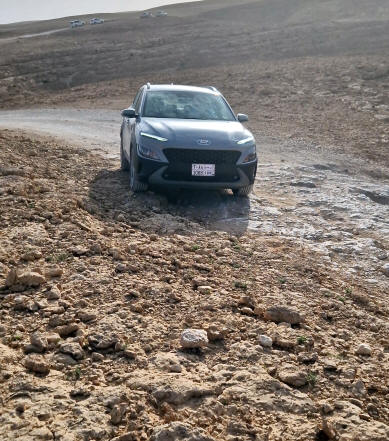

The left photo below was taken at the location marked Ф3. On the right is a photo from the Ф2 location, which was the most difficult for our car. It was necessary to climb and the wheels slipped.
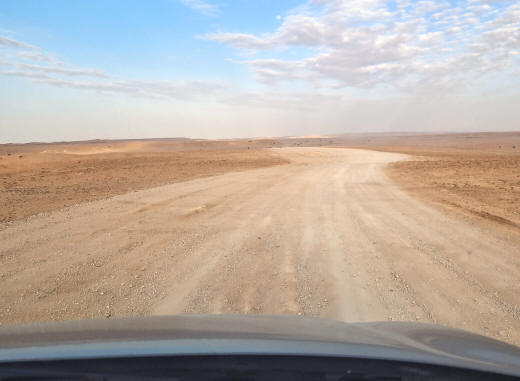
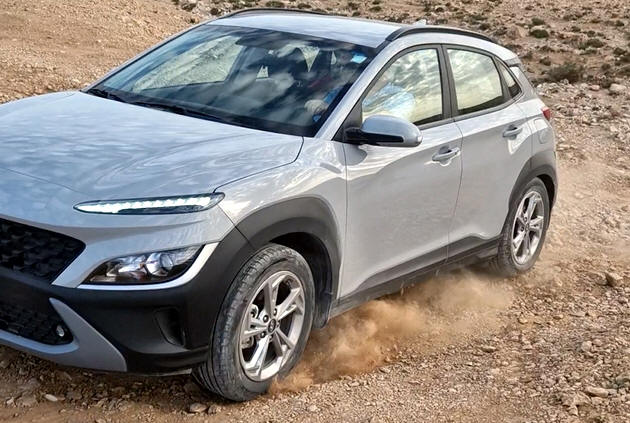
The bottom two photographs were also taken at location Ф2.

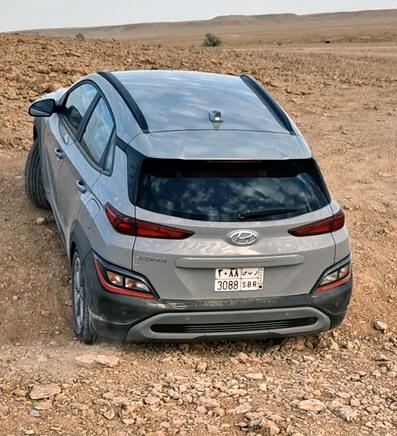
Camels were walking around, as shown in the photographs below, also marked as Ф2 on the map. Iouliia kept saying "don't run over the camel".
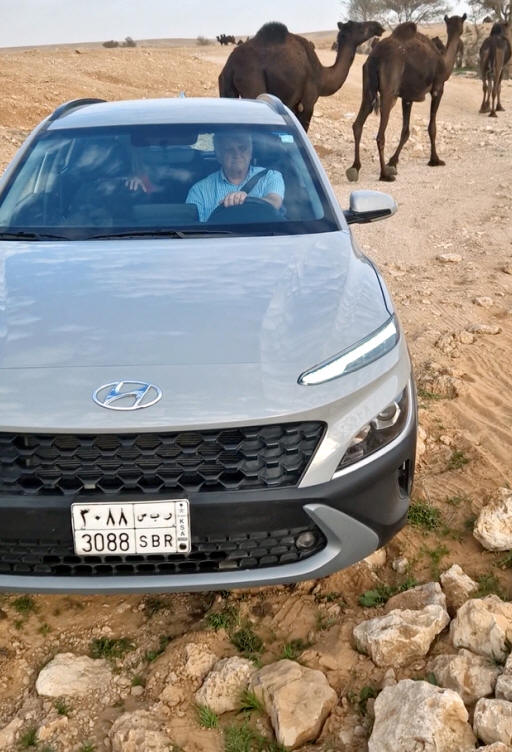

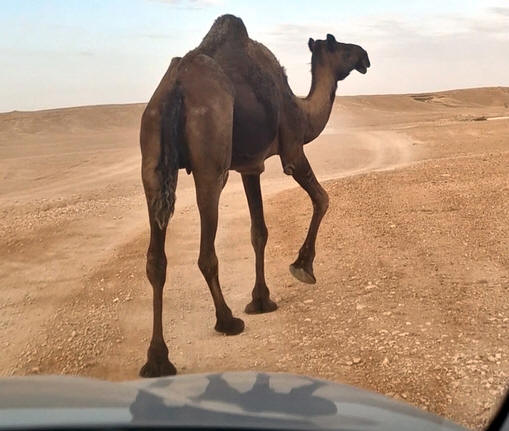
Below are two more shots with camels.
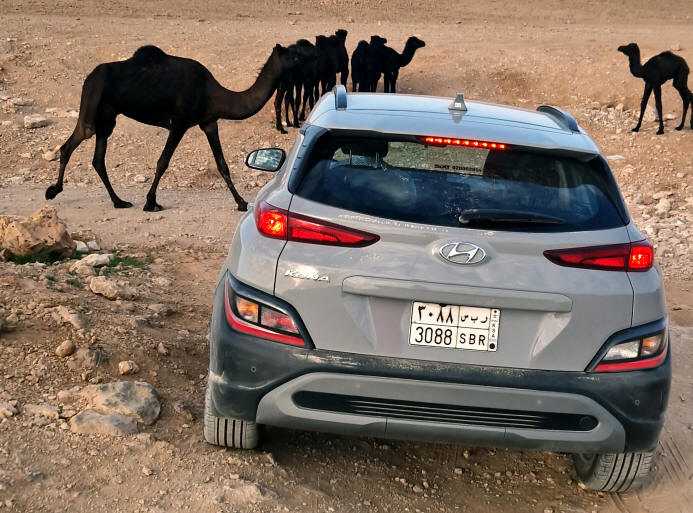
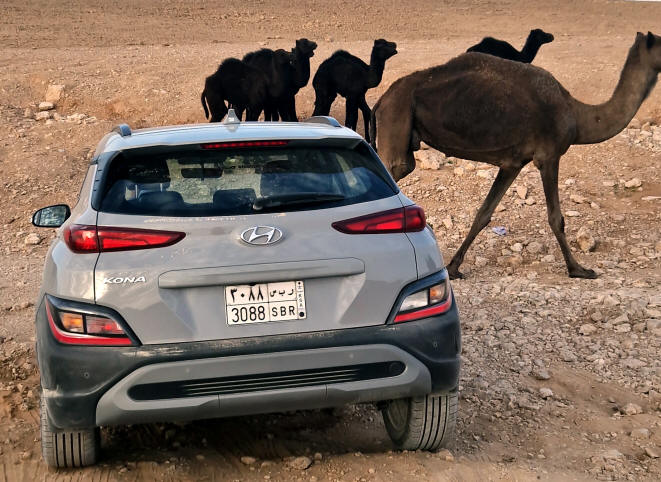
On the way back there were a lot of cars towards us. All were large and all-wheel drive. We began to be overtaken by other cars that were coming from the side of the Edge of the World (perhaps they were in a different place). We drove the slowest of all, but the car was the smallest. Halfway we met another small car, but it turned around and drove back. Below are the latest photos of our journey. Tha main dangesr for our car in the way are rocks, climbs (with rocks), and holes. See an exampe on the right-hand photo below.
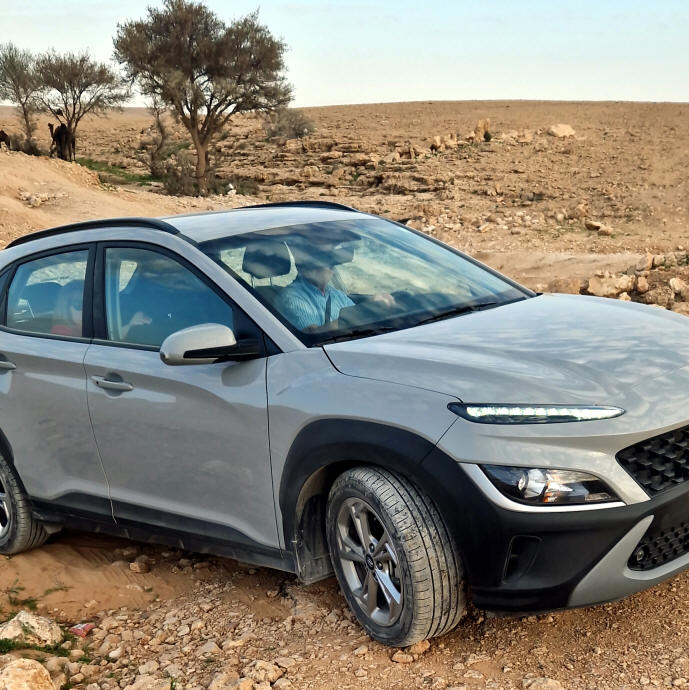
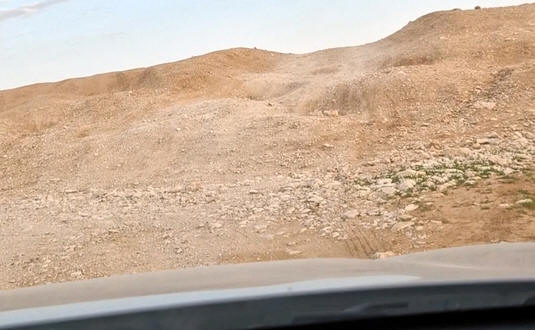
Finally we came to the paved road 5762. Below are the conclusions from this trip: 1) You should not go to this place in a car like our; 2) For a high four-wheel drive car, this road is simple (one might even say elementary) and, I think, it will not create any problem. Previously, we often traveled on roads that were much worse (examples: the Okavango Delta in Botswana, the volcanoes of Iceland, Easter Island - Chile, many roads in Oman, the route to Erta Ale volcano in Ethiopia, where on the way you can run into a mine etc .). However, everywhere in the mentioned above places we rented all-wheel drive high cars (we went to the Erta-Ale volcano with local experienced people). On such cars, we would drive the road to the Edge of the World in 40-50 minutes one way (or maybe faster). We did not see any difficulty for cars of the corresponding class; 3) Our car almost never slipped. The main problem is rockiness. In some places, millimeters remained before a possible touch with the stones. I had to constantly maneuver. We tried to pass wheels into high places to avoid impacts from below. It worked, but it is not guaranteed even in any of our similar trip. 4) We did not see places where it would be possible to slip in sand or gravel. If there were small problems, then only for cars like our on the slopes, where the stones slide a little; 5) We drove along the GPS trajectory laid out by other drivers (who drove here earlier) and Google. There were no problems with orientation. The Internet did not work, but the offline maps did their job perfectly. In addition, for the GPS tracer on previously laid routes, the Internet is not needed. We will never claim that the chosen road is the most correct and, moreover, the only one. There are many places in that area where you can drive, although not all of these places can be called roads. We are sure that there are other routes that we simply did not know. In conditions of limited time, it was impossible for us to search for these routes. Local drivers told us that we can only drive where everyone is driving and we were driving. I'm sure it's not correct. We just need to know more. How to find out more is difficult to say. The Internet, of course, helped us, but not very much for a specific route (leading to the Edge of theWorld).
A few words about the time of a day. Almost all descriptions on the Internet recommend visiting Edge of the World in the evening (or late afternoon). It is written that at this time there is good lighting and beautiful sunsets are observed. We were there from about 14 to 15. The lighting seemed to be good. You can take good photos. Most importantly, there were very few people, probably because everyone wants to be there in the late afternoon. We saw a lot of cars driving towards Edge of the World, mostly when we were driving back. Probably, many people visit this place and tours from Riyadh (that normally are organized from 14 hours). We knew about these tours. We found that the price of one of them was about 87 Euros per person (which is quite reasonable). Unfortunately, the tours did not fit into our plan, which included visiting other places.
Description of the 2013 Erta Ale volcano trip (mentioned above) can be found here: https://sweet.ua.pt/skl/NewTravelPage/Trips/EthiopiaJan2013English.html.
The map below shows the entire route of this day to the place of overnight stay at the hotel.
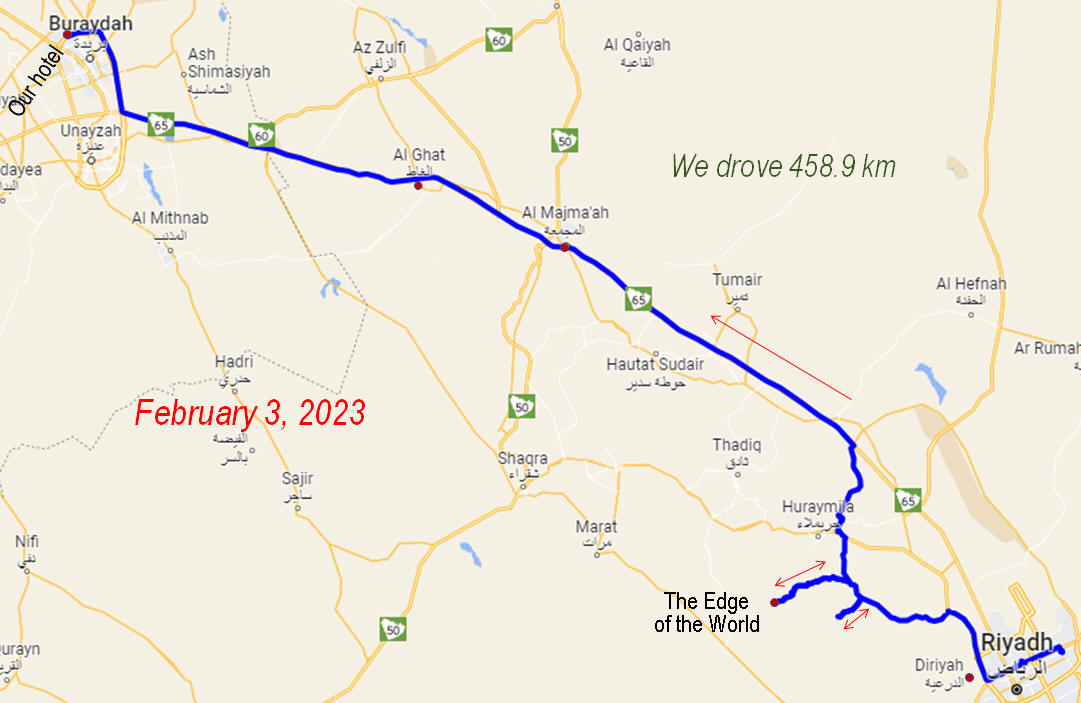
Soon after entering the asphalt road, it began to get dark. We continued on in the dark. The road is fast. Speed limit was 140 km per hour. At about 10 pm we already settled in the hotel of the city of Buraydah, which turned out to be very good. The main goal (Edge of the World) has been achieved. Below is a panoramic shot of this place, in which Iouliia is standing on the top of a pillar-shaped rock. There is a long road ahead in Saudi Arabia, where there is still much to see.

February 4, 2023. Continue on the path shown on the map below. First we drove through the desert. Then through the mountains.

The first stop was at a place called Elephant Rock. There is good free parking nearby. The entrance to the Elephant Rock is also free. The lighting was very good. There are two pictures below from this location.

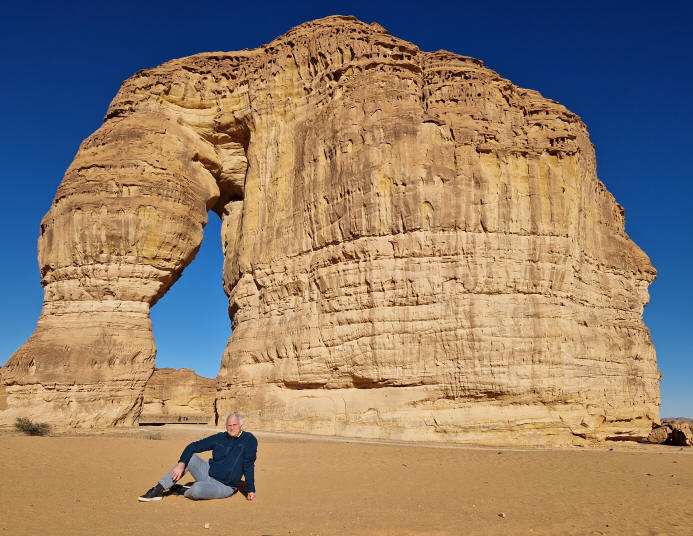
The next stop was near the historical site Dadan (Dedan). We drove up and found out that we were only allowed to visit this place with a guided tour. The last tour left for inspection 5 minutes before our arrival. The duration of the tour is 2 hours. We asked to see by ourselves, but we were told that we could not. So we didn't get here. There was no time. It seemed to us that the people in Al Ula are not quite the same as in other places that we visited in Saudi Arabia. Apparently they are a bit more spoiled by tourists. But overall, we liked the area.
From here we went to the old city of Al-Ula (see the inserted segment in the middle of the map above). We parked the car and entered the place on foot. Everything is made for tourists. Nothing intersting was found. On the way to the old city, we met two local women and a girl. This was perhaps the most interesting (see photos below). In the right picture below, Iouliia shows the height of the front bumper of our car. When we were driving on the roads of Saudi Arabia, we noticed that the front bumper of a lot of cars we encountered was beaten, and sometimes quite badly.
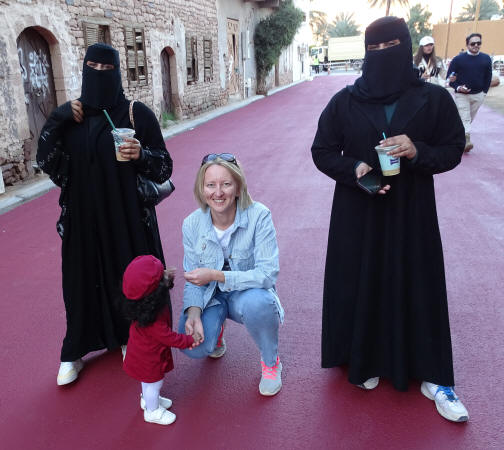
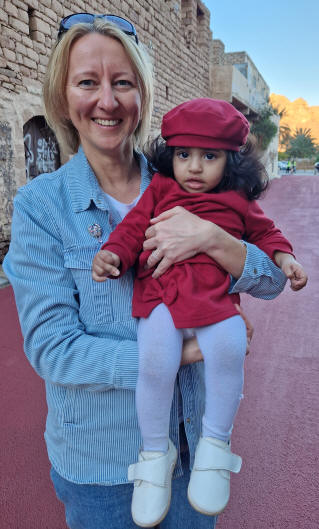
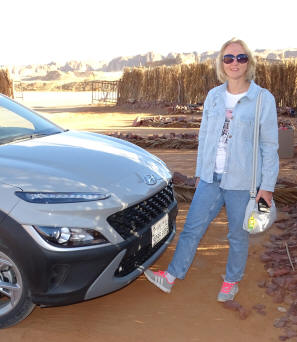
The left picture below was taken at the entrance to the old city. Two other shots were taken in the old city of Al-Ula.

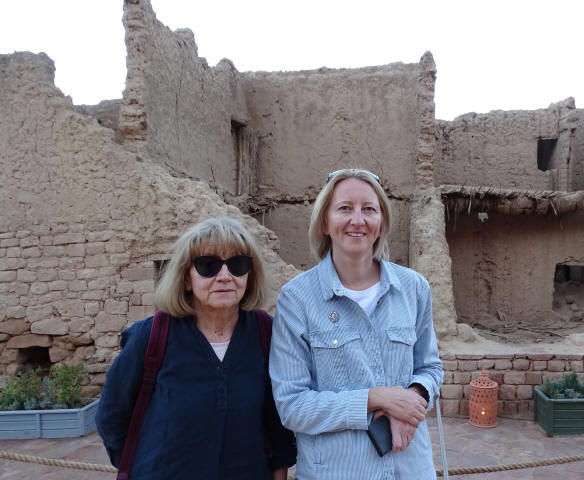
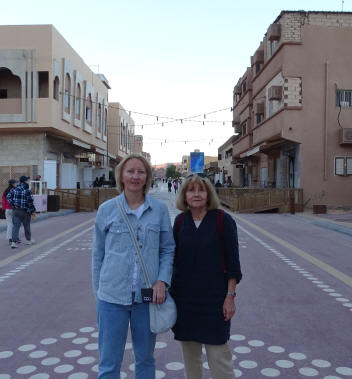
Then we went to the place of spending the night. We have been looking for such a place for a long time. Despite the fact that this is a tourist area, there were practically no hotels at a normal price. In some cases the prices reached up to 4000 Euro per night. With great difficulty, Iouliia found something cheaper for 350 riyals (about 87 Euros). We drove to this place. We came to a house. We entered the entrance and went up to the second floor. There were keys in the doors of two apartments. We opened one of them. Tania immediately said that there was something prayerful there, and we immediately closed the door. We knocked on all the other doors, but no one opened us. We went outside and knocked on the door opposite. Nobody opened it either. We return back to the house and see that a car stopped near. An Arab man comes out of there and invites us first to the entrance, and then to the apartment, the door to which we opened slightly. There we will live.
We entered the appartment. There were some kind of bedspreads on the beds. They are clean, but there are no sheets. Tania and Iouliia began to express dissatisfaction. The man accompanying us could hardly say anything in English and constantly pronounced one word - new. I understand as it's all new. After long negotiations, we realized that it was useless to discuss something. Then another tenant arrived, who settled in the apartment opposite. He were introduced to us as an Australian, but he was also a Saudi. He offered to help us translate into Arabic. We asked for sheets, but we were told that they do not needed. Accommodation in overnight places is a separate topic and I will write about it at the end of this description. Now we had nothing to do. No other accommodation can be found. We stayed. The owner reduced our price from 350 to 300 riyals. So we paid about 75 Euros. The room was large - three rooms and a kitchen.
In the morning the owner knocked and brought us Arabic coffee. In the evening, he offered to have a chicken dinner with him, but we refused. The owner was very cheerful, constantly saying something. He tried to do something and help. So even after sleeping on beds without sheets, it was hard to say something bad to him. The night went well and thanks for that.
February 5, 2023. In the morning we took pictures with the owner, who arrived before 7 o'clock (see the left picture below). There is a jug of coffee on the table. In this room we looked first yesterday (when Tania said that there was something prayerful there). Then we packed up and went to the Winter Park, from where we had pre-booked an excursion to one of the most famous places in Saudi Arabia - Madain Salih (Hegra district). We arrived, parked the car, registered, and began waiting for the bus to depart. The middle shot below shows the bus. On the right in this picture is another person about whom I would like to tell. When we were waiting for the bus, this man spoke to us in Russian. We asked him where he was from. The answer is "what do you think?". We named Russia, Belarus and Ukraine in turn, but did not guess correctly. He is from the Polish city of Gdansk. His name is Wojciech Miloch. He is Polish but works at the University of Oslo in Norway (Professor in Plasma and Space Physics). So we met another Wojtek from Gdansk, who often visits Antarctica (for work) and travels a lot.
The bus brought us to the starting point of the tour. It says on the internet that you can't park your car there. However, we saw a large parking lot nearby. We started asking employees. We were told that the car could be left here as well, which, of course, would have been more convenient for us. I will not argue that it is really possible to leave the car. We did not leave our car and did not stop by this parking lot. In Saudi Arabia, information even from workers can be wrong. The established rules change frequently. First, we were treated to juice and various sweets. Iouliia took a picture with a local lady (see right photo below), who was one of the organizers. The tour was a little chaotic, but we again liked the people who conducted it. They reacted to questions immediately. They said that they would make inquiries if they did not know the answer, etc.


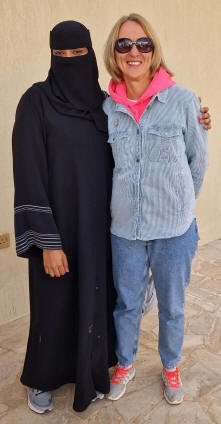
Then we were put on another bus and we went to see Mada'in Salih (Al-Hijr), which the guides called Hegra (maybe even rather Higra, or maybe that's how we heard the word Hijr) . Below are brief details about this place.
Most of the remains date from the Nabataean kingdom (1st century AD). Madain Salih is the southernmost and second largest city of the (Nabataean) kingdom after Petra in Jordan (we were in Petra in 2007). Madain Salih is the first World Heritage Site of Saudi Arabia. The Nabataean settlement of Hegra was built around a residential area and its oasis in the 1st century AD. The sandstone outcrops are carved to create a necropolis. We traveled by bus and looked at the burial sites, which are shown below on the route map and photographs.

The left photo below was taken in the Jabal Al Ahmar (Jabal Al Banat) area. Entrances to burials are carved and processed in sandstone. The photo next to it was taken near the Tomb of Lihyan, son of Kuza. It is assumed that this building was erected in the 1st century AD. In the right picture (taken by Wojtek), all three of us are near the Jabal Al Banat site.

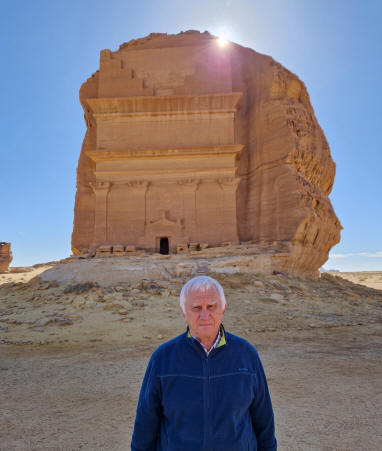
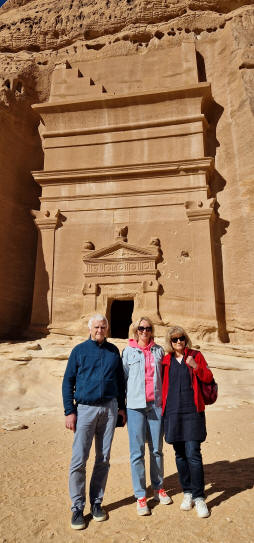
There are below four more photos from this place (Madain Salih), which is one of the most famous in Saudi Arabia. Additional details are not provided here. All these details can be found on the Internet. The left picture below was taken at Jabal Al Banat. The right picture is from the place of the last stop in the Al Divan area.
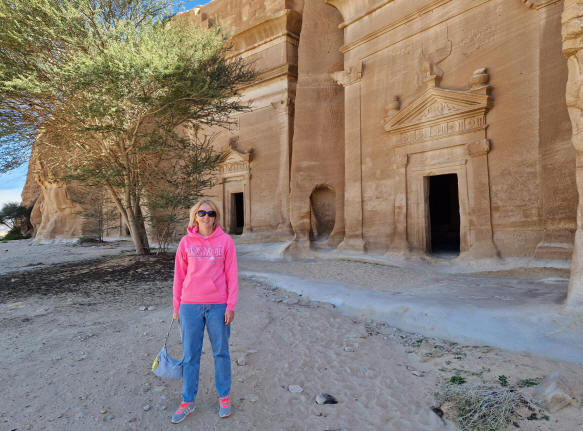
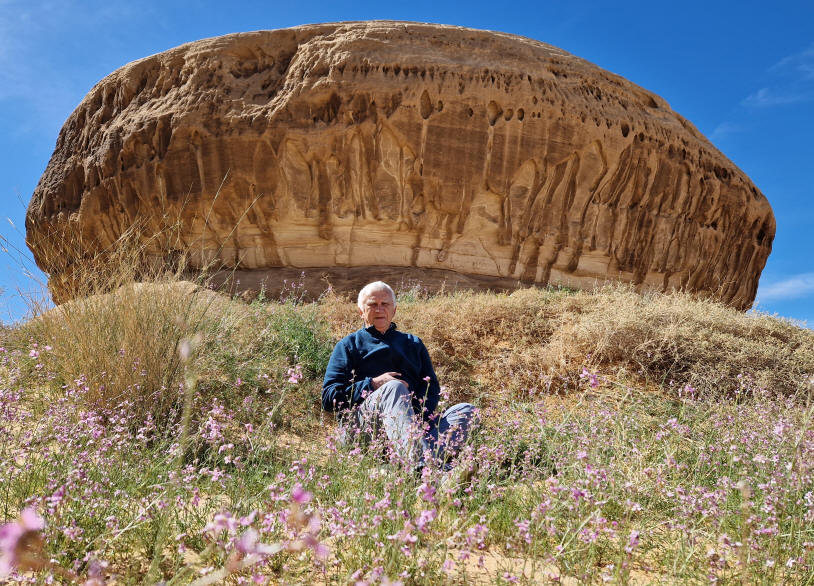
The left picture below was taken at Jabal Al Banat. The picture on the right is a large room in the Al Diwan location. There they told us a lot and showed us figures carved in sandstone. All the places listed above are shown on the map above. In general, I liked it. But this place is undeniably inferior to Petra in Jordan.

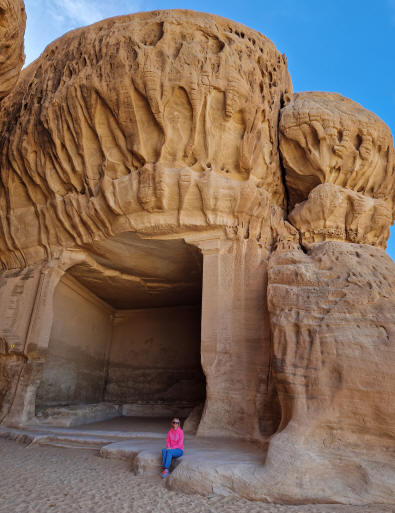
In conclusion, two panoramic shots from the Madain Salih site are given.


After the end of the tour, we returned by bus to the Winter park. There were only a couple of cars in the parking lot. We picked up our car, drove Wojtek to the old city of Al-Ula, and continued our journey to the city of Medina (Al Madinah). This is the second most important city in Islam - the cradle of Islamic culture and civilization. The Mosque of the Prophet (Al-Masjid an-Nabawi) is the burial place of the Islamic prophet Muhammad, who built this mosque in 622 AD. The city existed for more than 1500 years before the migration of Muhammad from Mecca.
We arrived in Medina and started looking for a parking place in the city center. All the places marked on the map did not work or the passage to them was blocked. We started trying to negotiate with hotels and in one of them we were allowed to go down to the underground parking and leave the car there for 20 minutes. We parked the car and ran to the Prophet's Mosque. Our round trips took 25 minutes (total distance 1.17 km). The gates were open. There were only local people around. We took some photos. There was no one at the entrance. People didn't pay much attention to us.
Then we ran back. We took the car (they didn't take money from us for parking) and drove to the sacred mountain Uhud. We stopped somewhere near and asked a local man about the mountain. He showed where this mountain is. He walked away, then returned and pointed to the place where we can take the best picture of the mountain. We drove up there. We got out of the car. Two women approached us and offered to take a picture of us (Tania stayed in the car). The two pictures below show a mountain and a photo with the women (Mount Uhud is in the background). They asked for our phone number (WhatsApp) so we could send them photos. Soon (after completing the trip to Saudi Arabia) they contacted Iouliia and Iouliia sent them photos. We liked the people in Saudi Arabia. They are a little different, but easier to communicate with than in many neighboring countries.


Then we went to the hotel (more than 100 km from Medina), which turned out to be the best during our stay in Saudi Arabia. It was very nice. The map below shows the entire route of the day. Fragments during the visit to the city of Medina are enlarged and shown separately.
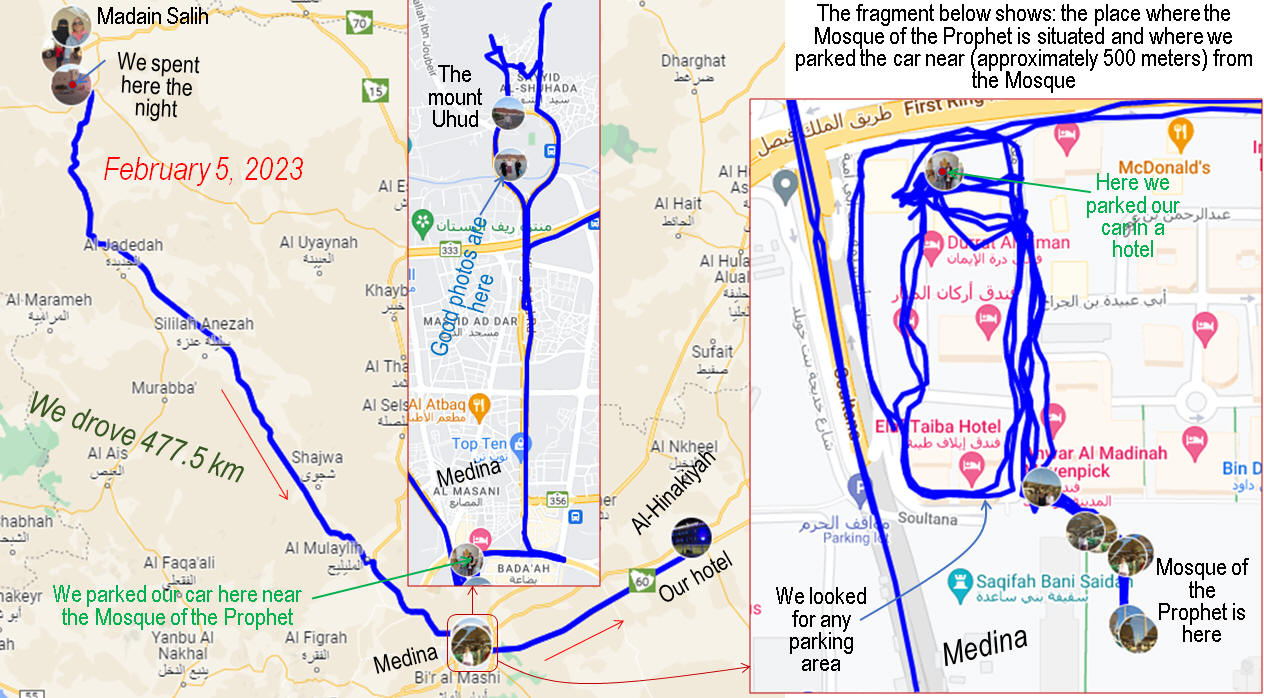
February 6, 2023. On this day, we had to get to Riyadh airport, from where, at about 2 am (February 7), we had to fly back to Portugal. I wanted to stop by the crater Al-Wa'bah, which was about 270 km from the hotel. However, the road to the airport through this crater would require 10 hours of continuous driving (distance 1010 km). We thought that such a long journey before the flight was risky and decided to drive through the old Arab villages/towns about 200 km from Riyadh. The distance from the city of Jeddah to the Al-Wa'bah crater is 325 km. We do not leave the thought of visiting Saudi Arabia again. We have multiple entry visas for a year. So there may still be an opportunity to look at this crater.
On this day, we decided to relax a little and left (hotel) at about 10 am. First we went to the city of Buraydah, where we were already on February 3rd. Then we went to look at the old Arab villages/towns. Iouliia also drove a little more than 500 km in the second car, which is confirmed by the two left pictures below. She was even stopped by the police, which checked all the documents. Now Iouliia says that: 1) women can drive in Saudi Arabia; 2) all her documents are in order; and 3) no one required an international driver's license.

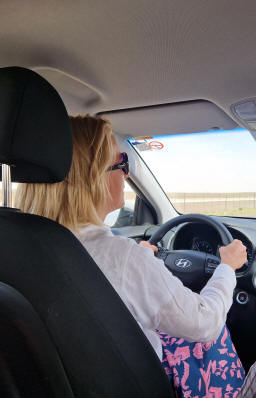

The first stop was in the village of Ushaiqer. This is one of the oldest settlements in the Saudi region. According to information on the Internet, Ushaiker means "Little Blonde" (this is the name of the nearby mountain). The old adobe buildings of this village are still intact. It really is, and we really liked it there. There are below three photographs from this village.
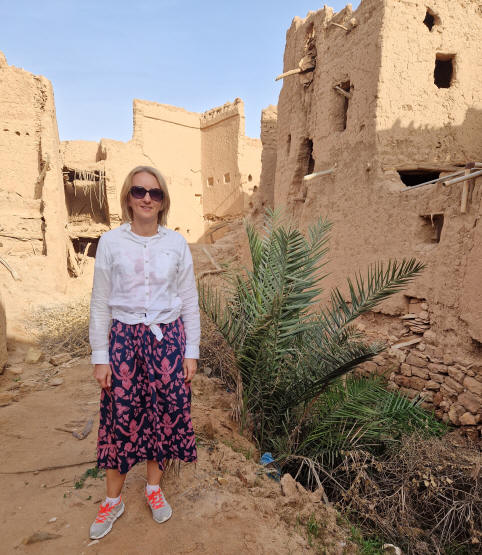 .
.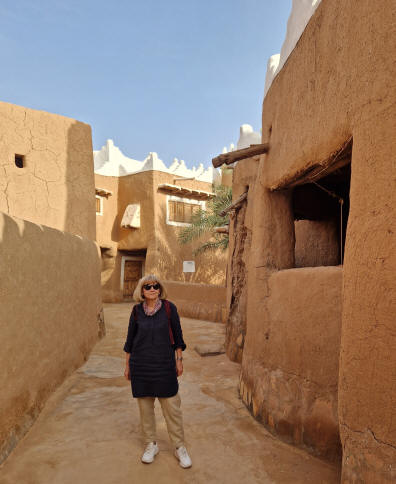
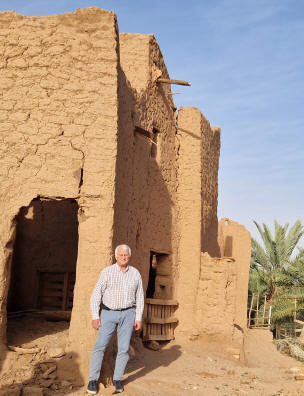
Below are three more photos from the same village. In the background of the right picture you can see our car, which has already passed a lot.
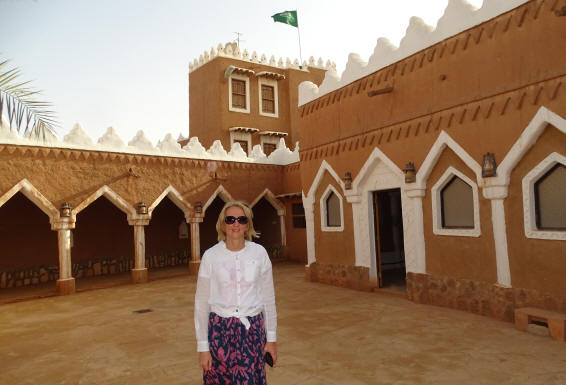
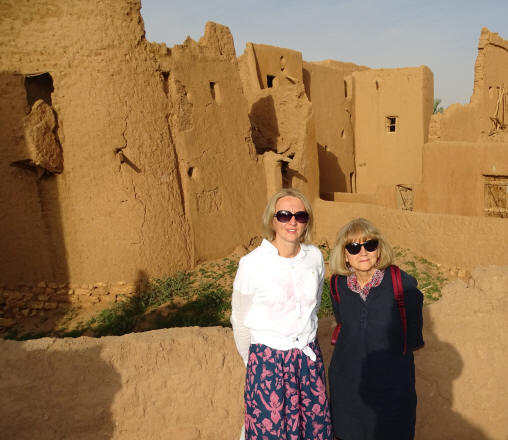
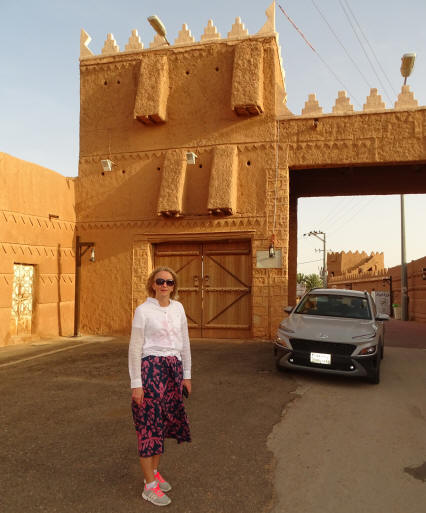
From Ushaiqer we went to the town of Shagra, or rather to its old part. Below are two shots from this place, which I also liked.

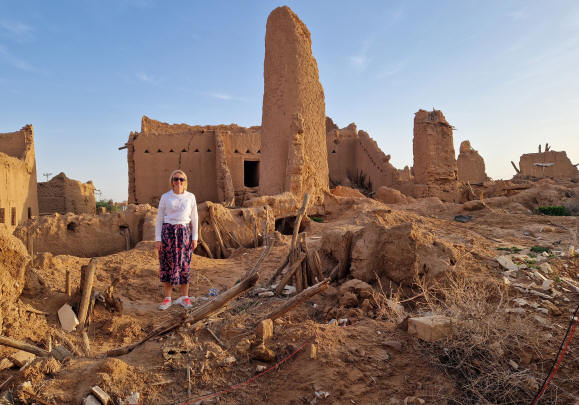
The next two stops were the towns of Tharmada and Marat. In Tharmada we were met by locals (see left photo below). They offered coffee, but we didn't have time (thus, we had to refuse). We continued inspection (see the middle shot below). Then a local resident called us to the upper part (see the right picture below). We went through several rooms and climbed the stairs. From there we could see the entire old city. This place turned out to be one of the most interesting.
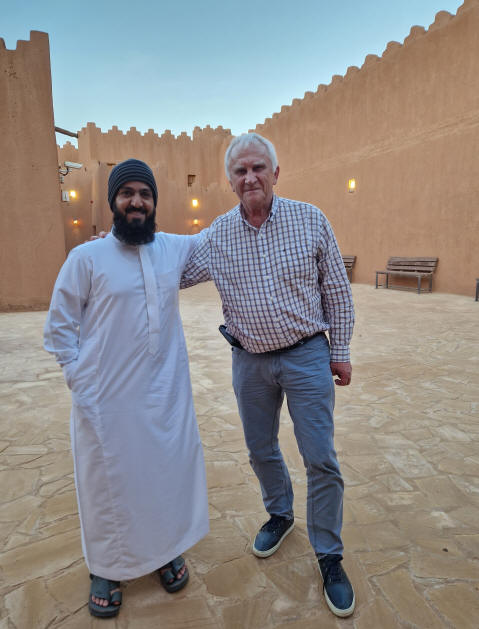
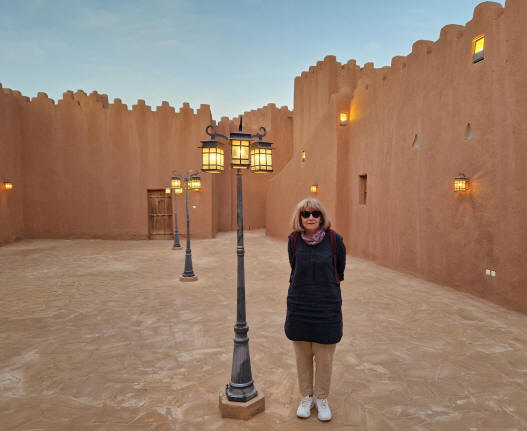

Below, on the left, another shot is shown from the upper part, from where all the buildings were visible. The right picture was taken in the old part of the city of Marat. It can be seen that it is already getting dark and we need to move to the airport. We still need to drive about 180 km. We could see a few more interesting villages (a little away), but we decided to go straight to Riyadh. We stopped at the store, had a bite to eat and went to the airport to return the rented car.
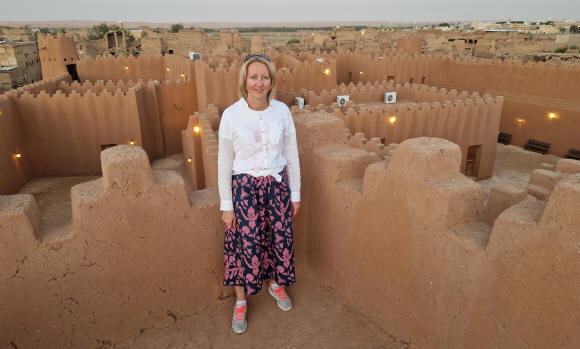
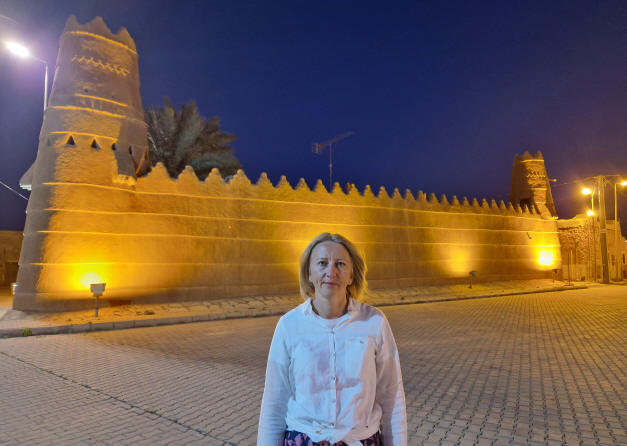
In conclusion, two more panoramic pictures from this region of the
visited Arab settlements are given.


Below is a map of the day's itinerary highlighting the area of the visited villages/towns.
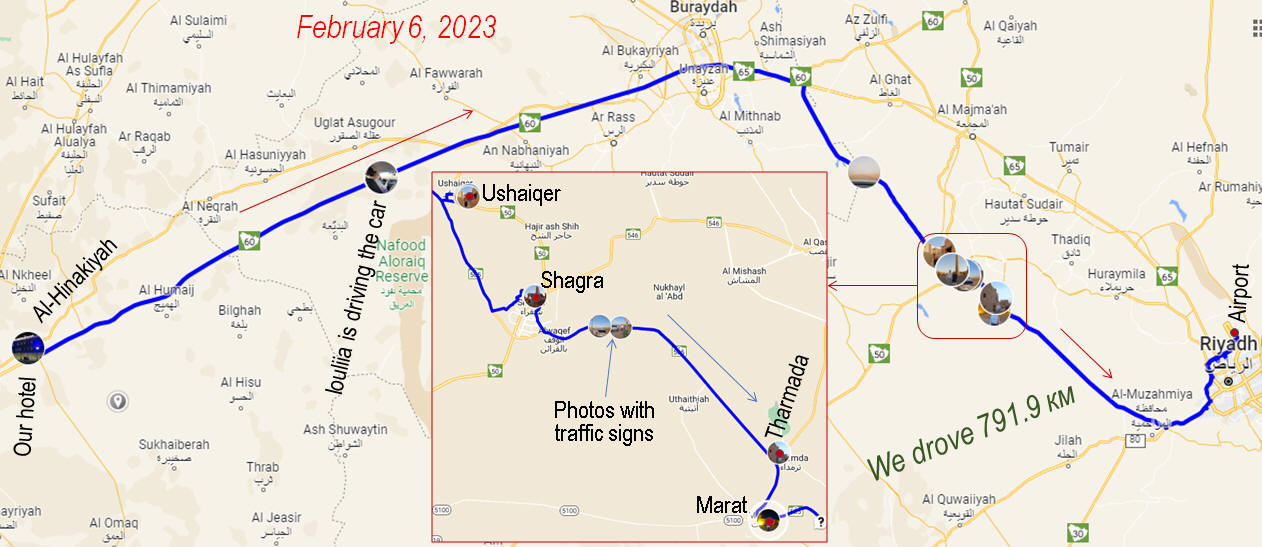
We use Arabic numerals. In Saudi Arabia, the numbers, of course, are also Arabic, but they are written differently from ours. It's hard to understand right away. The photos below show a few examples of road signs along our way. The speed limits are written on them (from left to right): 120, 50, 60, and 100 kilometers per hour. So I had to re-learn.
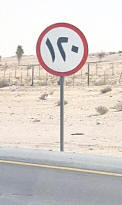



We returned the car at the fifth terminal of the airport (that is, where it was taken) at 21h30m, that is, exactly as the indicated time. Both cars were fully insured, but neither was needed. I don't think it's wasted money. We do not limit ourselves in movement. We drive on difficult roads, through the central parts of big cities, etc. Anything can happen. We drove 2503.6 km in the second car (of which Iouliia drove a little more than 500 km and I did the rest). Iouliia also drove the first car for about 20 km. So I drove a little more than 3 thousand in two cars and Iouliia - the rest.
The map below shows the general itinerary of our two car trips in Saudi Arabia.

On the night of February 6-7 (at 01h50m) we flew by Luftansa airline from Riyadh to Frankfurt (the flight took about 6 hours). The plane to Porto was supposed to take off from Frankfurt at 09h50m, but it was delayed by about an hour. We flew a little over 2 hours. We picked up our car at the airport parking lot and drove home.
General conclusions on this trip:
1. A lot of things in Saudi Arabia are different than they were in our other trips. For example, housing, almost everywhere, was multi-room and large. Almost everywhere there was a kitchen, which we never used. Before flying to Saudi Arabia, we found out that often in a triple room there is only one large bed on which all three people need to sleep. In this regard, in the hotel of Riyadh, we replaced the rooms and received those in which there were separate beds (accordingly, we paid a little more than planned). In the hotel of the city of Al-Hofuf (night from February 1 to February 2), the three of us slept on such a bed. This bed was really very large and there was practically no inconvenience.
2. People everywhere treated us well. Their clothes are peculiar, but they did not bother us. The face of local women is practically (with rare exceptions) always closed. This is a different country and different customs. We must accept them as they are. The most important thing is that everyone we met (both men and women) treated us well and it was easy with them. We did not notice any inconvenience with the local population. Visitors (like us) are not required to wear the same clothes as locals. Tania and Iouliia wore scarves only in the mosque. In cities and villages, they went without scarves and without special clothes, that is, practically, just like in Europe. The local people were not shocked.
3. Food was a little more difficult. Restaurants are expensive. And we didn't have time for restaurants. Almost all the time we ate at fast food places (McDonald's and analogues). Even there the prices were higher than in many European countries. For example, in recent years we have bought great pizza in Italy at a price of 5-9 Euros. For a similar pizza (which was prepared in Saudi Arabia, apparently, by the Chinese) we paid more than 15 Euros. In the city of Al-Ula, we visited a sweet shop several times. There we bought very tasty black dates. Many other tasty things are sold there, for example, good sweets. Prices are quite normal. For example, the price of the most expensive black dates was about 15 Euros per kilogram. The candies were cheaper than similar candies in Europe.
4. Alcohol is banned in Saudi Arabia. I immediately tuned in to an absolutely sober lifestyle and perceived it quite calmly. Tania was the most worried. She often said that after our difficult trips (such as to the Edge of the World) we should relieve some stress with a glass of wine. In general, everything was fine. We drank delicious juices and felt good. On the way back on the plane, many passengers had a great time and demanded several glasses of wine. I limited myself to one glass, like Tania.
5. Rented cars, taking into account additional insurances, were more expensive for us than usual. When renting any car, Sixt (our rental company) blocked 3,000 riyals (approximately 750 Euros) on the credit card. Since we took two cars, such a blockage also happened twice. I asked why? We took insurance with a liability of 0. They answered that this was for possible police fines. They said that if everything was Ok, then this money would be unblocked in three weeks. Everything was unblocked for us a few days after the return, that is, much earlier than promised. We refueled the cars with gasoline 91 (so we were told in the company). We paid, basically, 2.18 riyals per liter (0.545 Euro). In the Al-Ula area, gasoline was slightly more expensive - 2.22 riyals per liter. Actually, we did not even pay attention to such a difference. Fuel is indeed very cheap. The main roads (outside the cities) are fast. Most often, the speed limit is 110, 120 or 140 kilometers per hour. I liked how big trucks drive. They drive in the right lane and very rarely only move to the second lane when the road is three lanes. Three-lane roads are quite common. Car traffic in cities (especially in Riyadh) can be chaotic with no rules being followed. Cars can overtake even through a double lane (both on the right and on the left, even on the side of the road). Despite this, I did not see any difficulty in driving a car (Iouliia agrees with me). We can not say that it was difficult to drive (even in the center of cities such as Riyadh and Medina). The rented cars were almost new and in good conditions. Radars were often seen along the roads. We were stopped twice by the police. Once me and once Iouliia. They checked my driver's license and said that we can continue on our way. They checked Iouliia's driver's license, car documents and even tried to talk a little. We saw a lot of police checkpoints. We were almost always let through without stopping. Some cars were stopped. There were practically no cars with non-local drivers on the roads. On the way to the Edge of the World, we saw several jeeps in which there were people similar to the Chinese. It should be noticed that many people who looked like Chinese spoke Arabic. Maybe they are already local. When we returned the first car, we saw a woman of European appearance, who was also returning a rented car and was alone. We did not see other drivers of European appearance on the roads and parking lots. During the lease, only people of local appearance rented other cars.
6. The weather was good all the time, the
temperature was comfortable, there was no rain, there were no sandstorms
either.


It is planned to translate these books in English